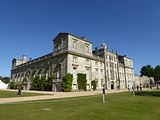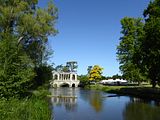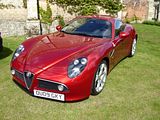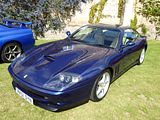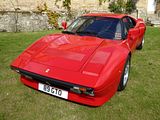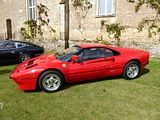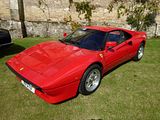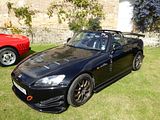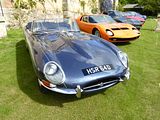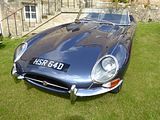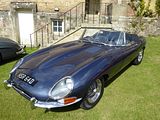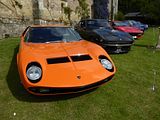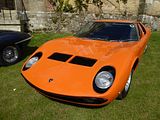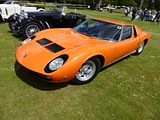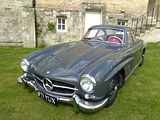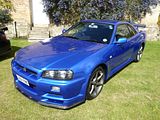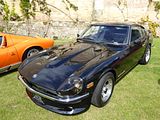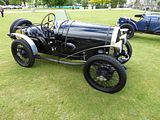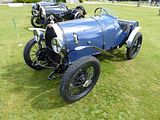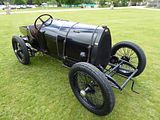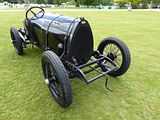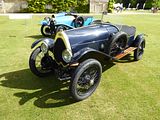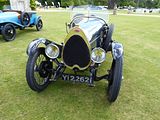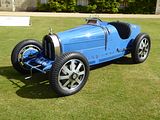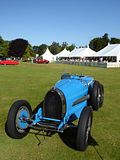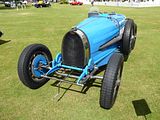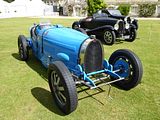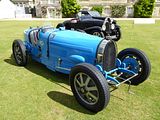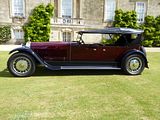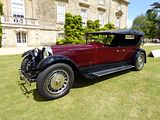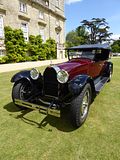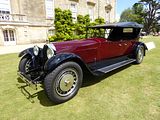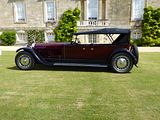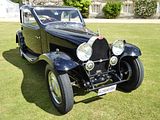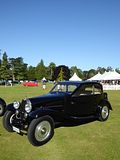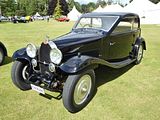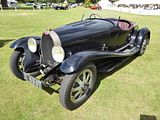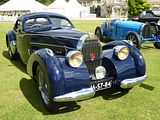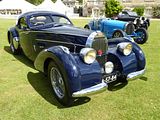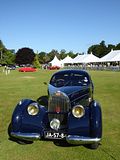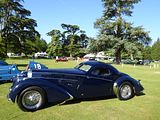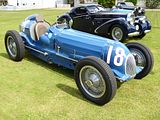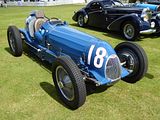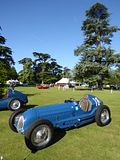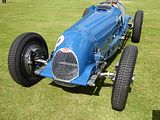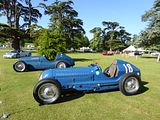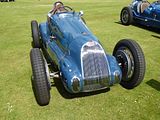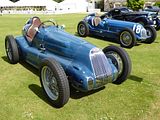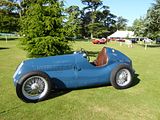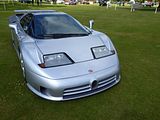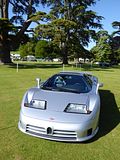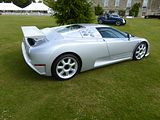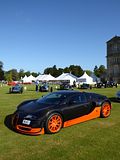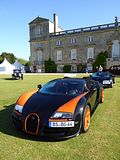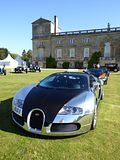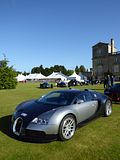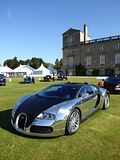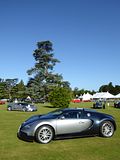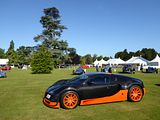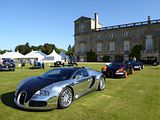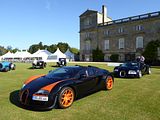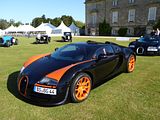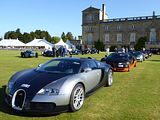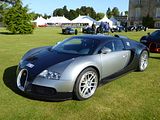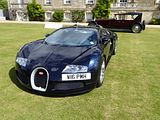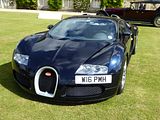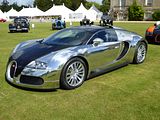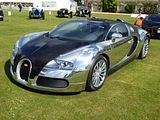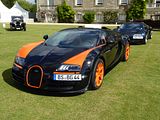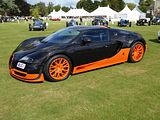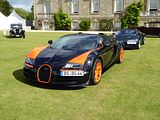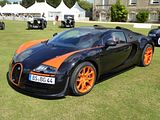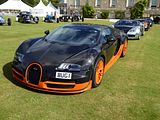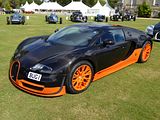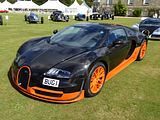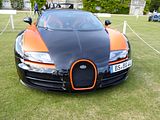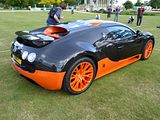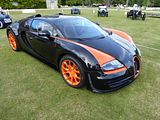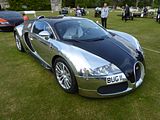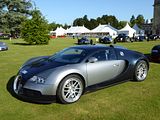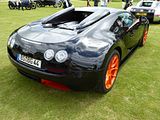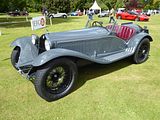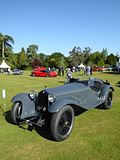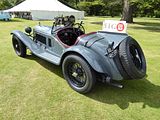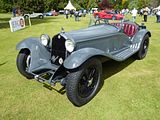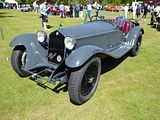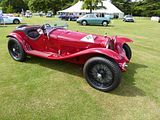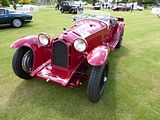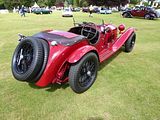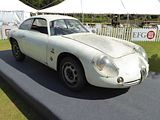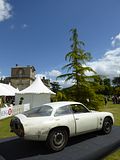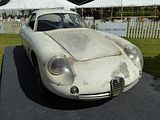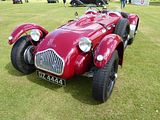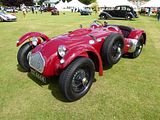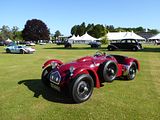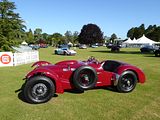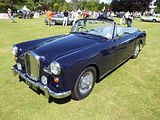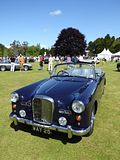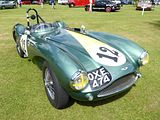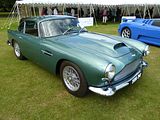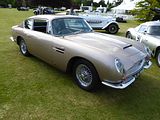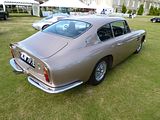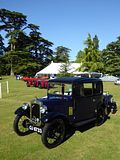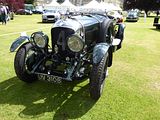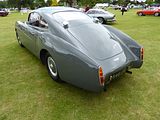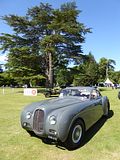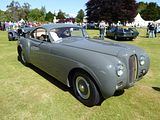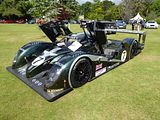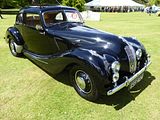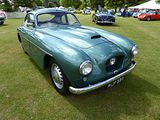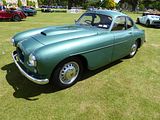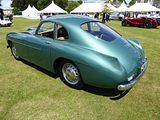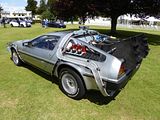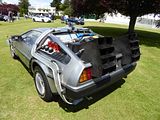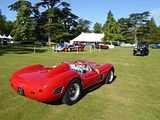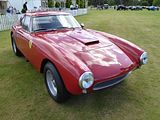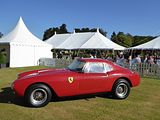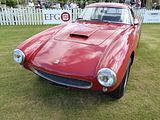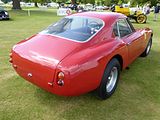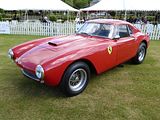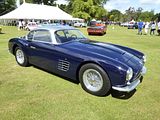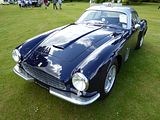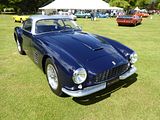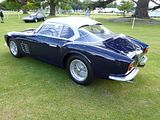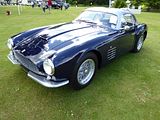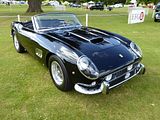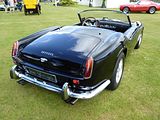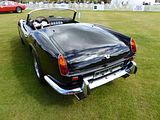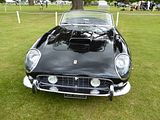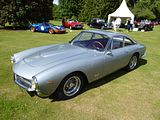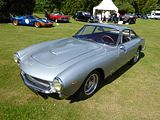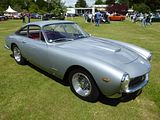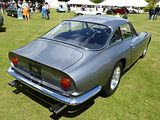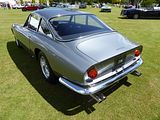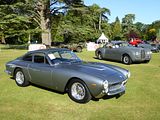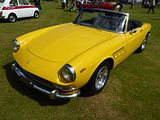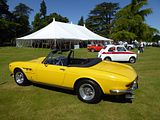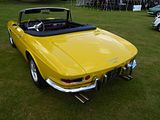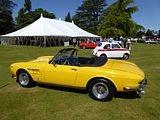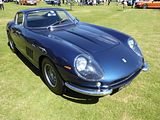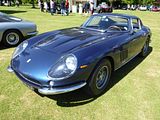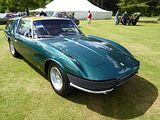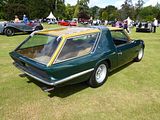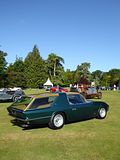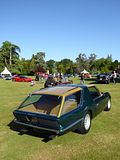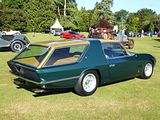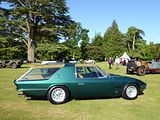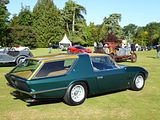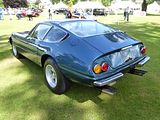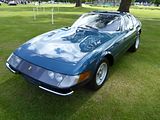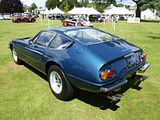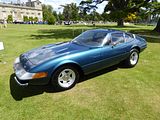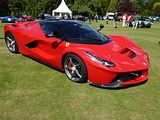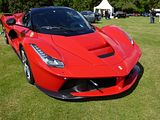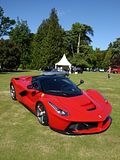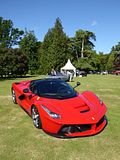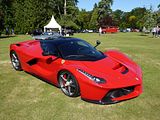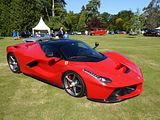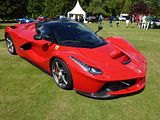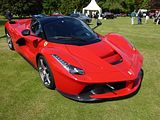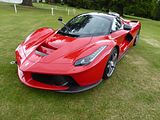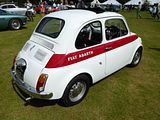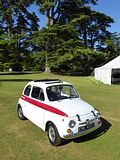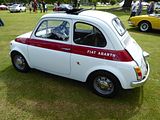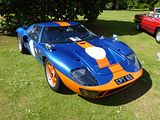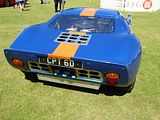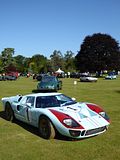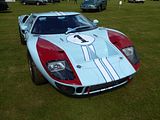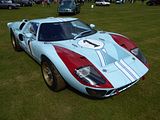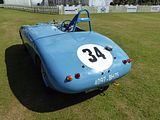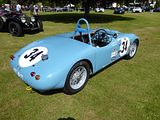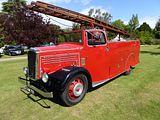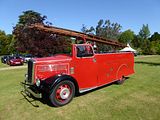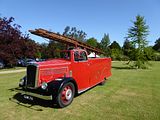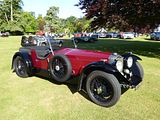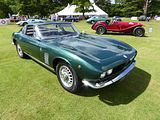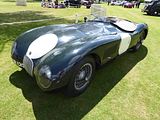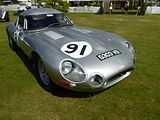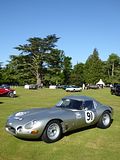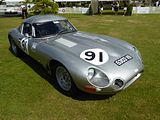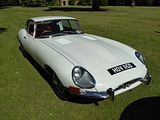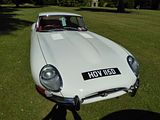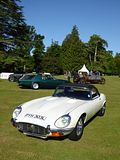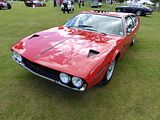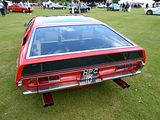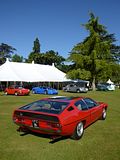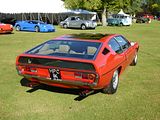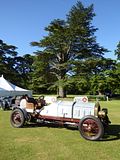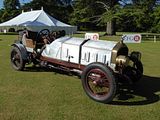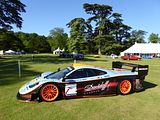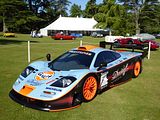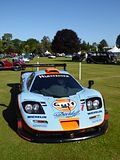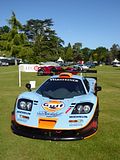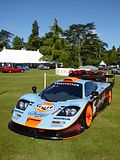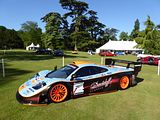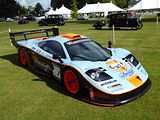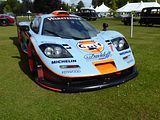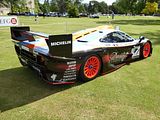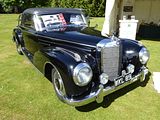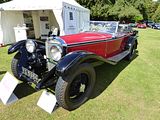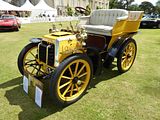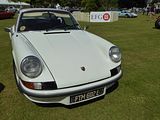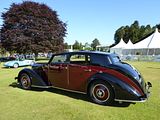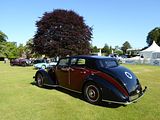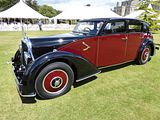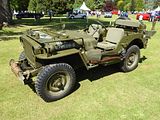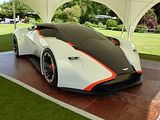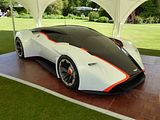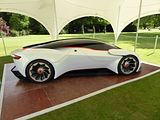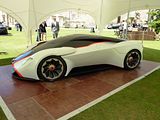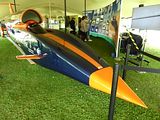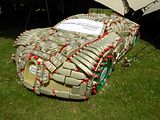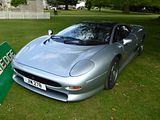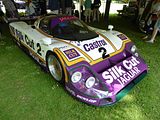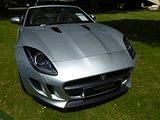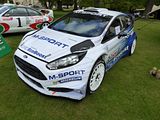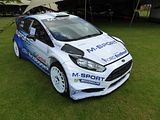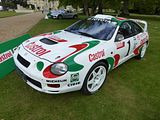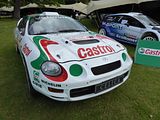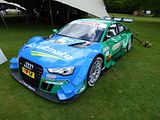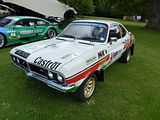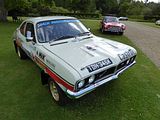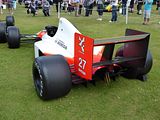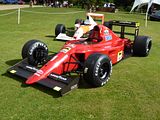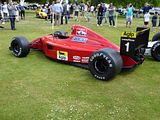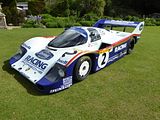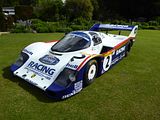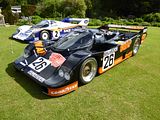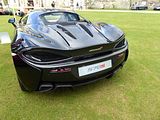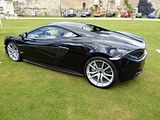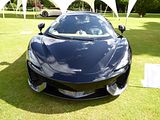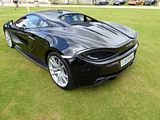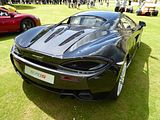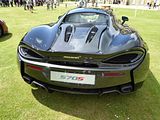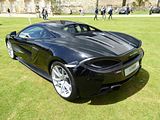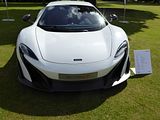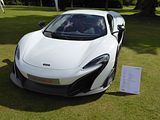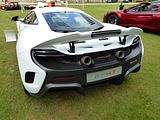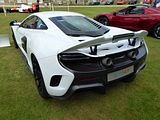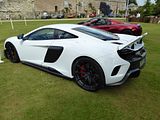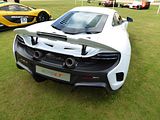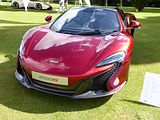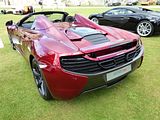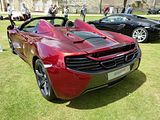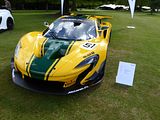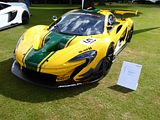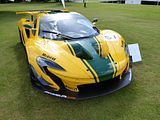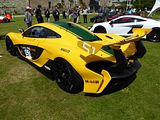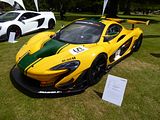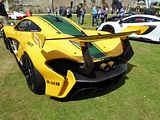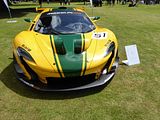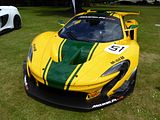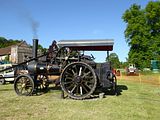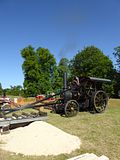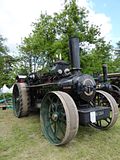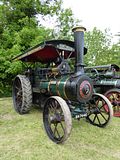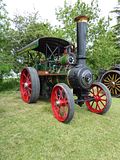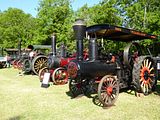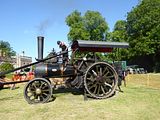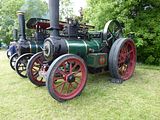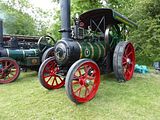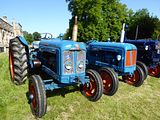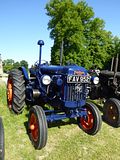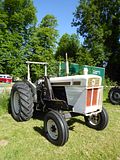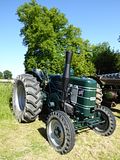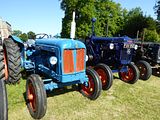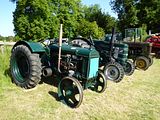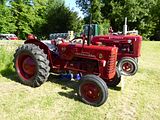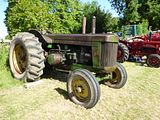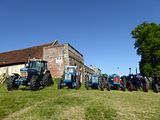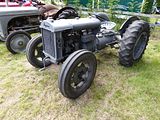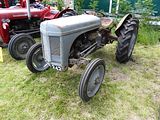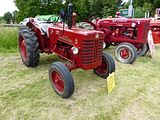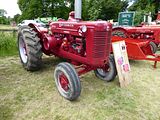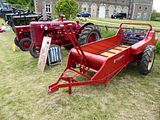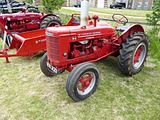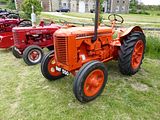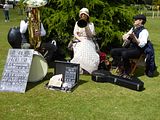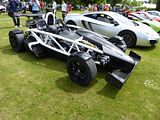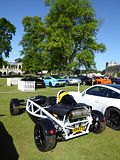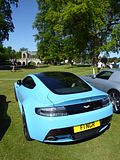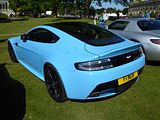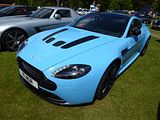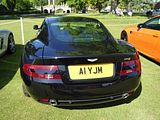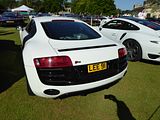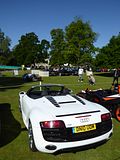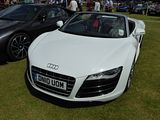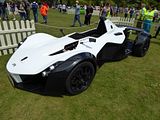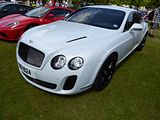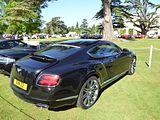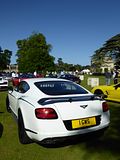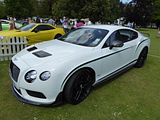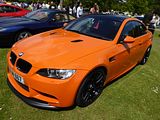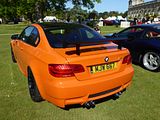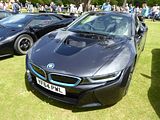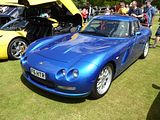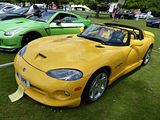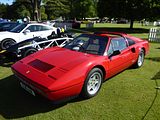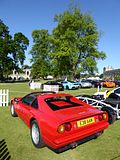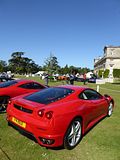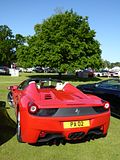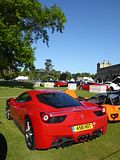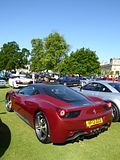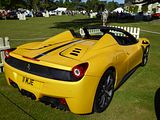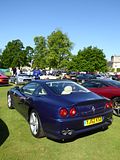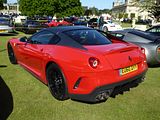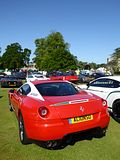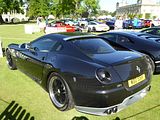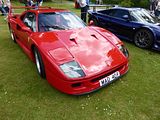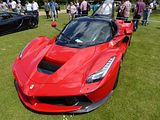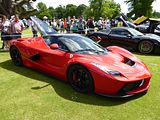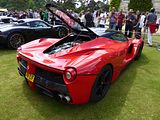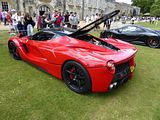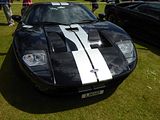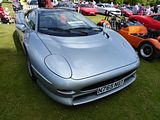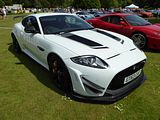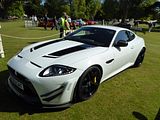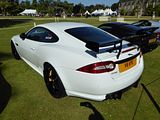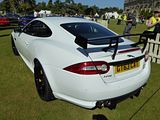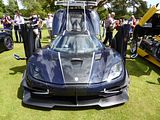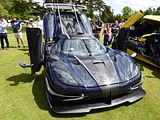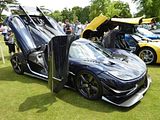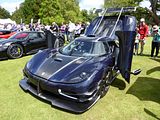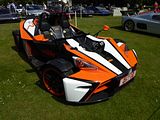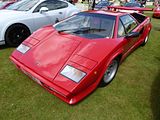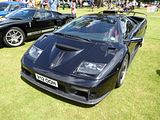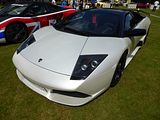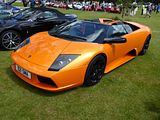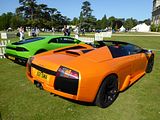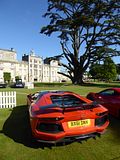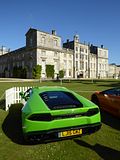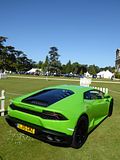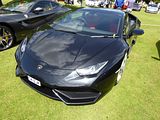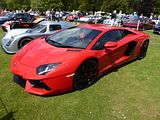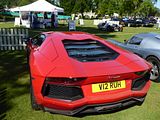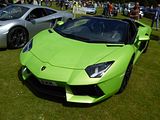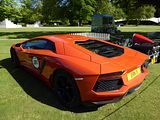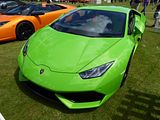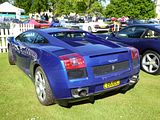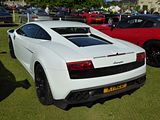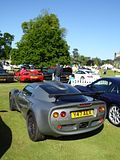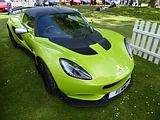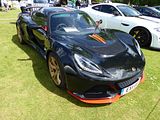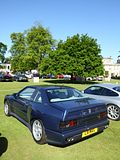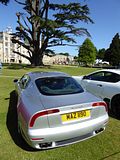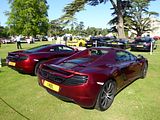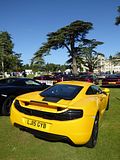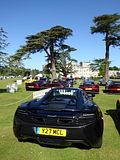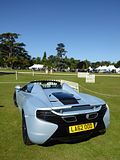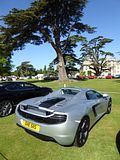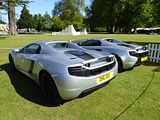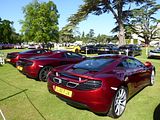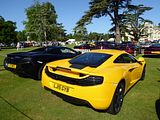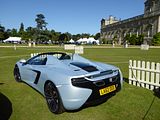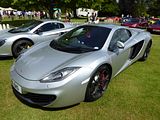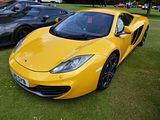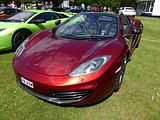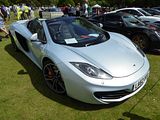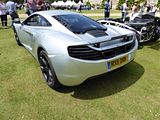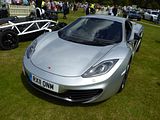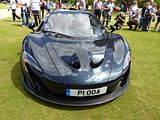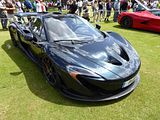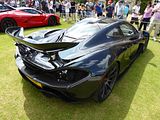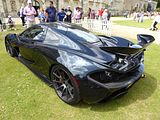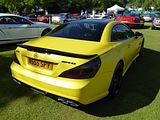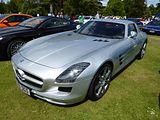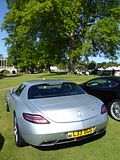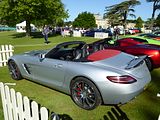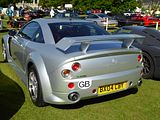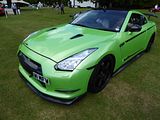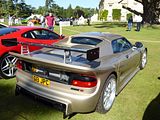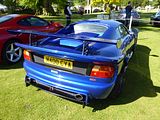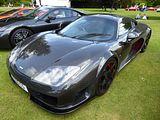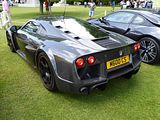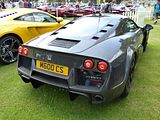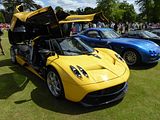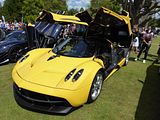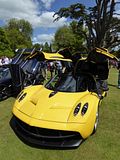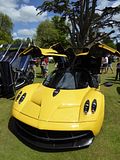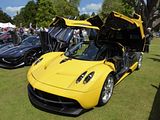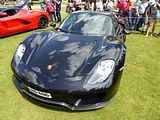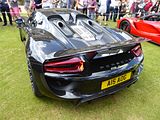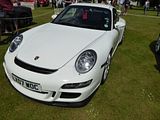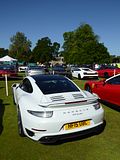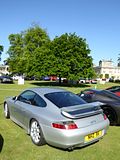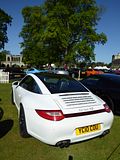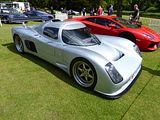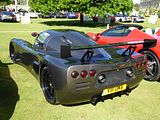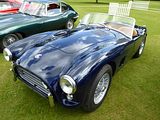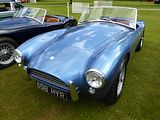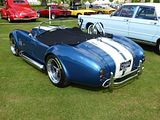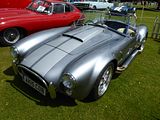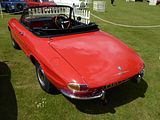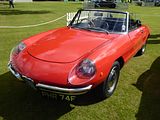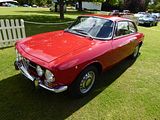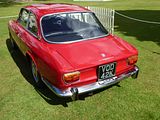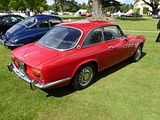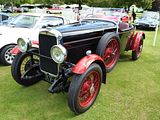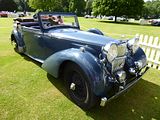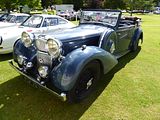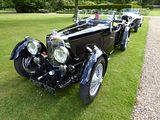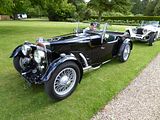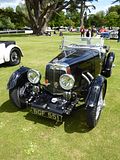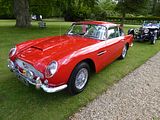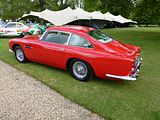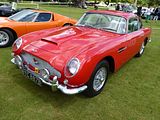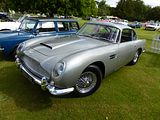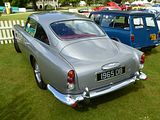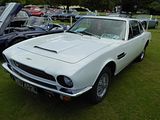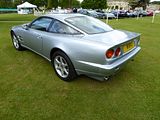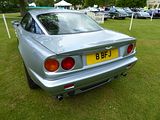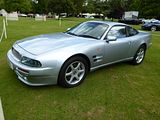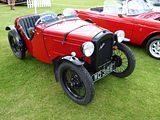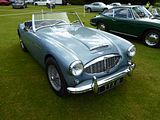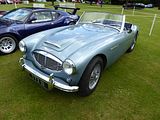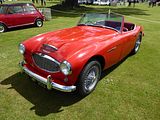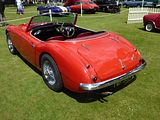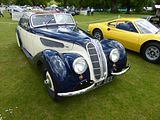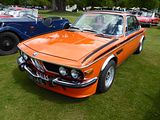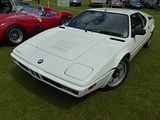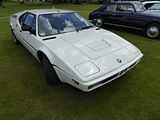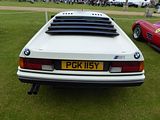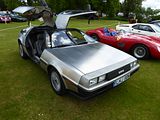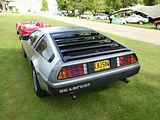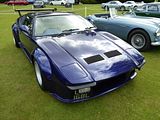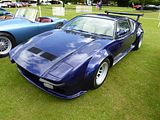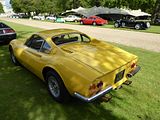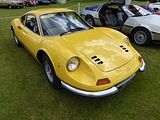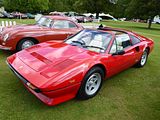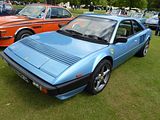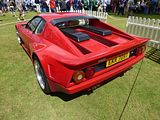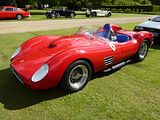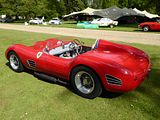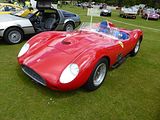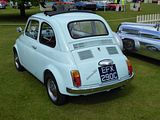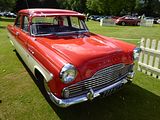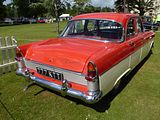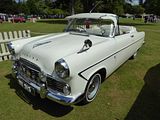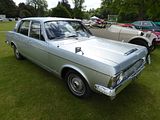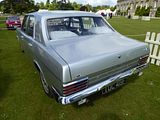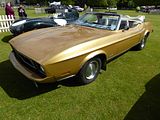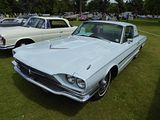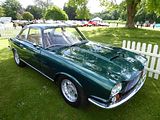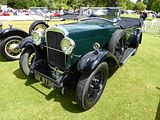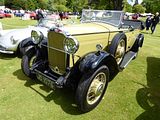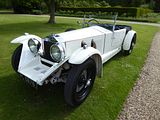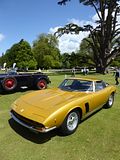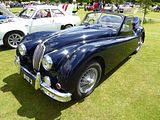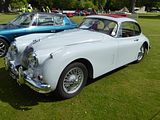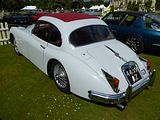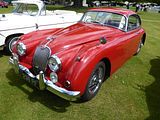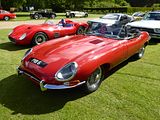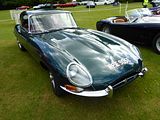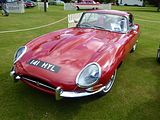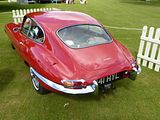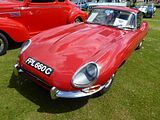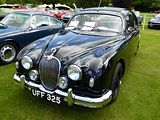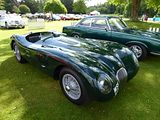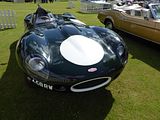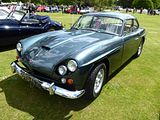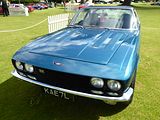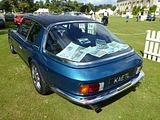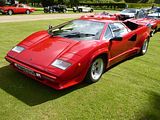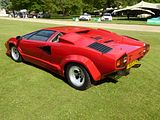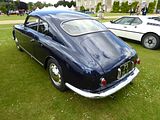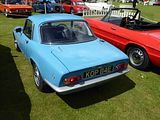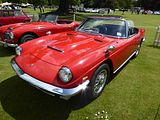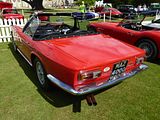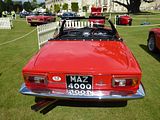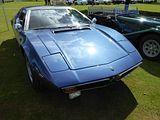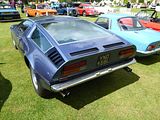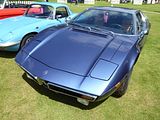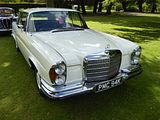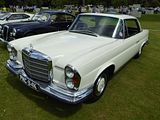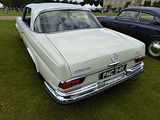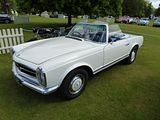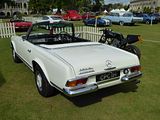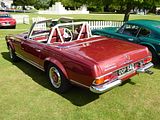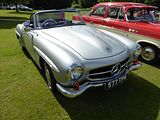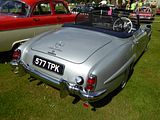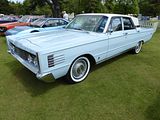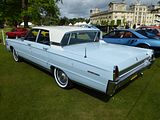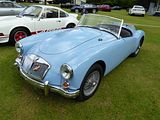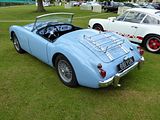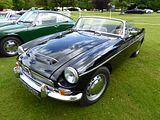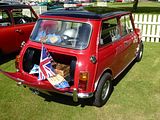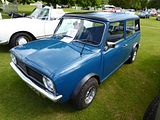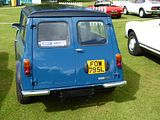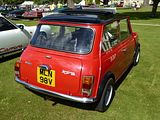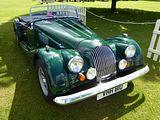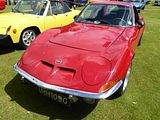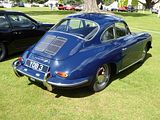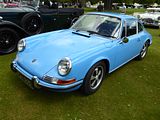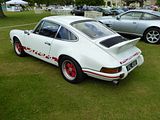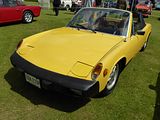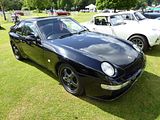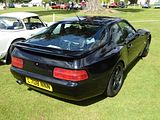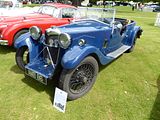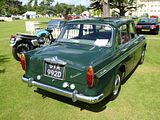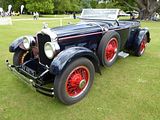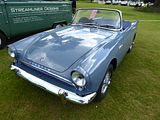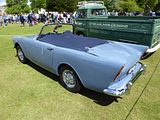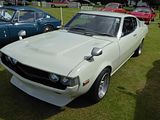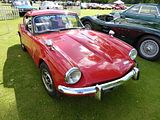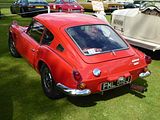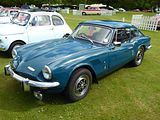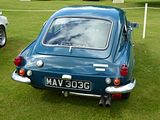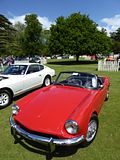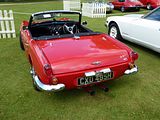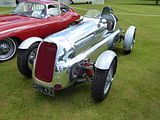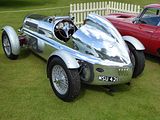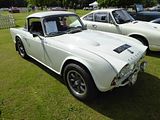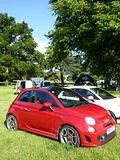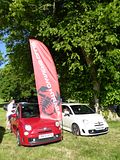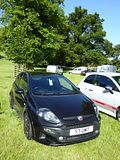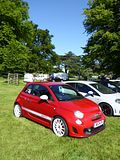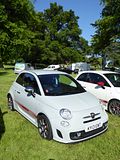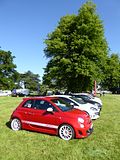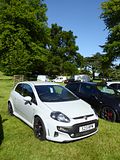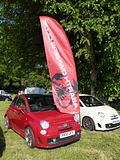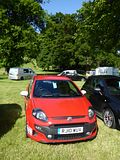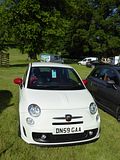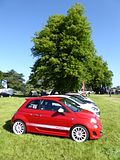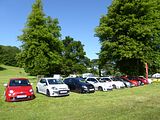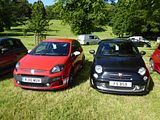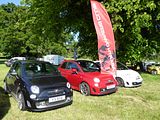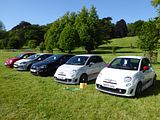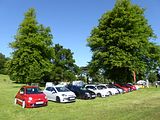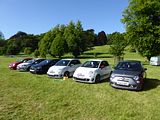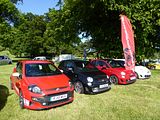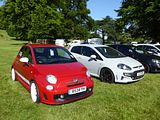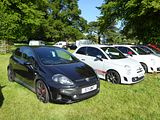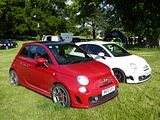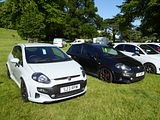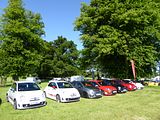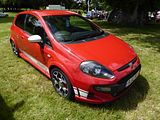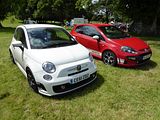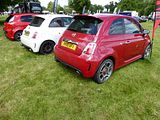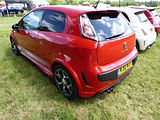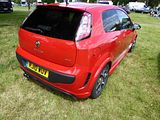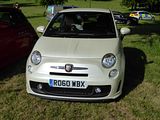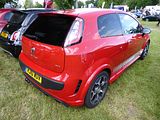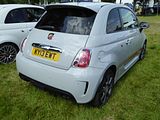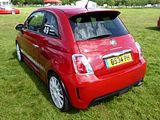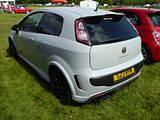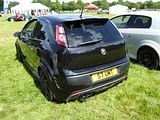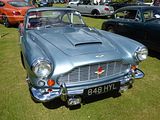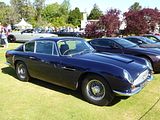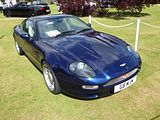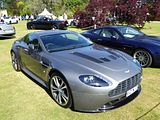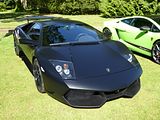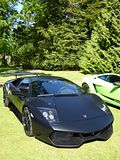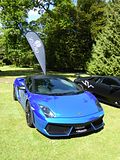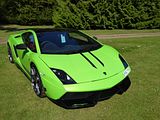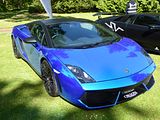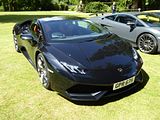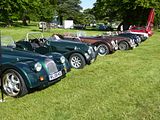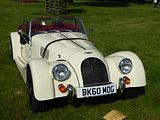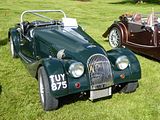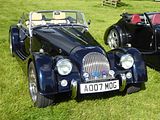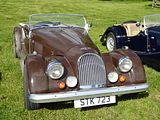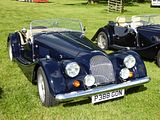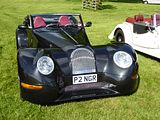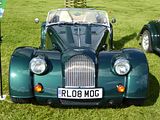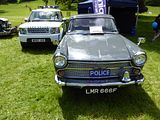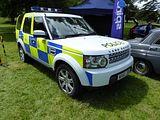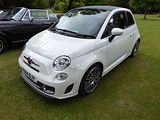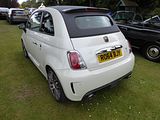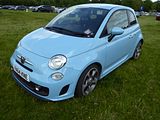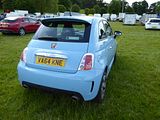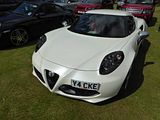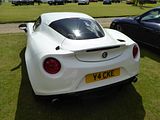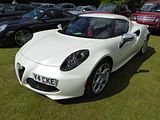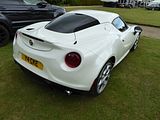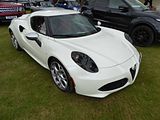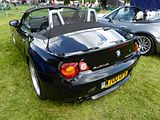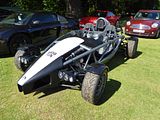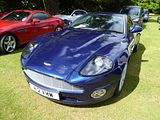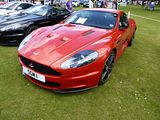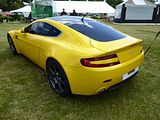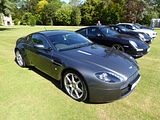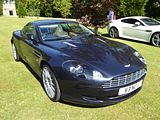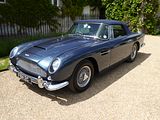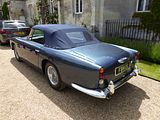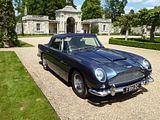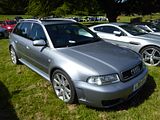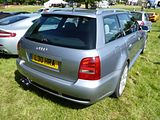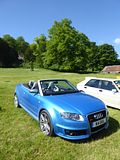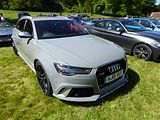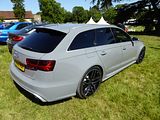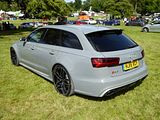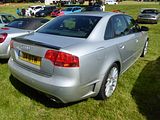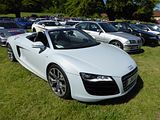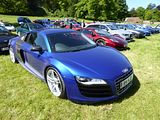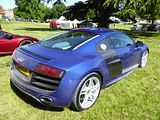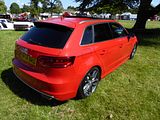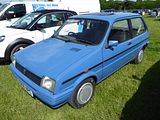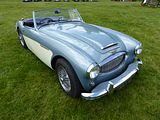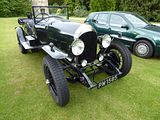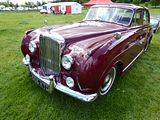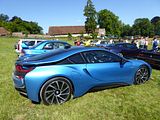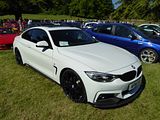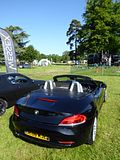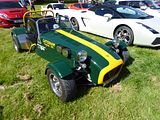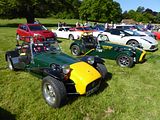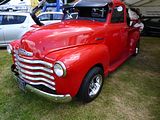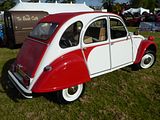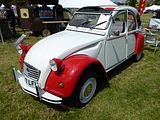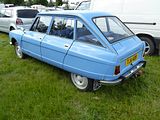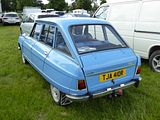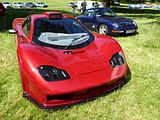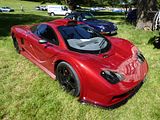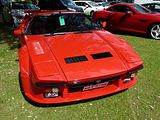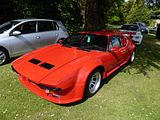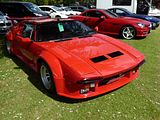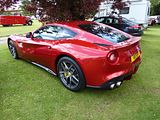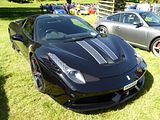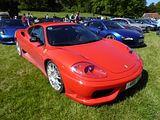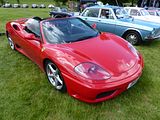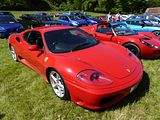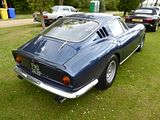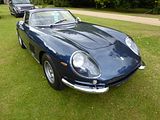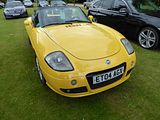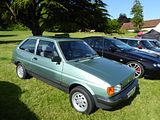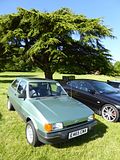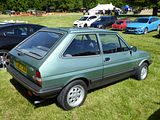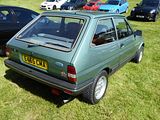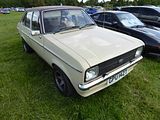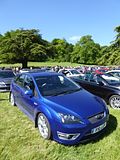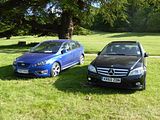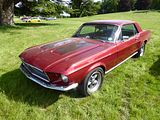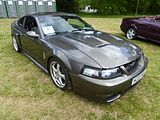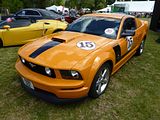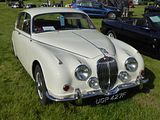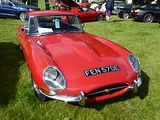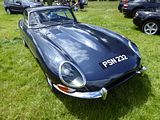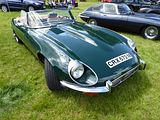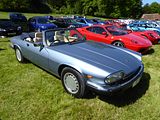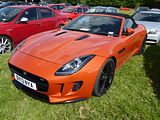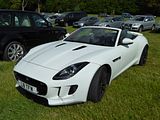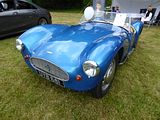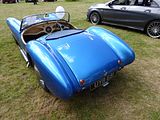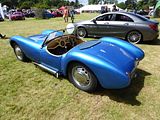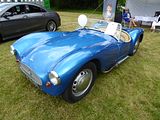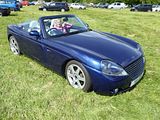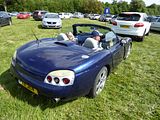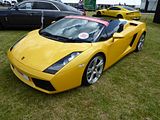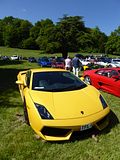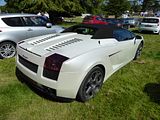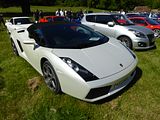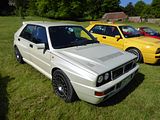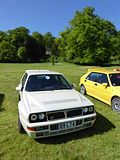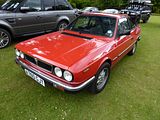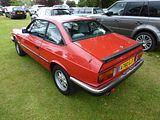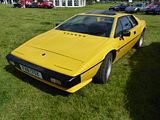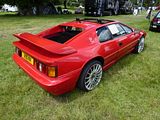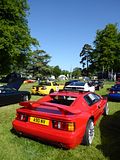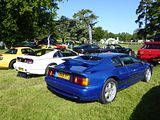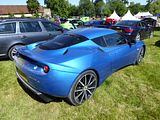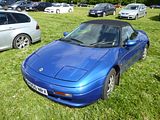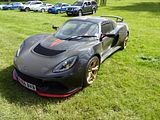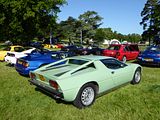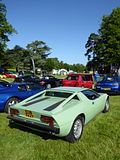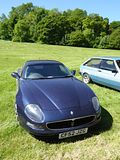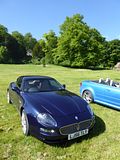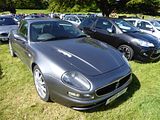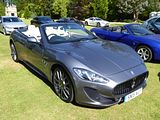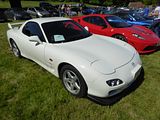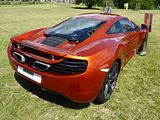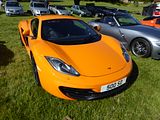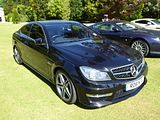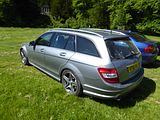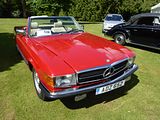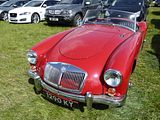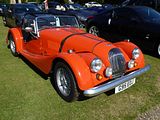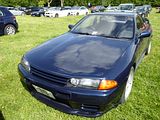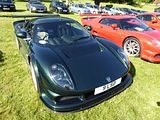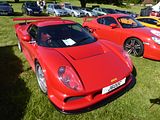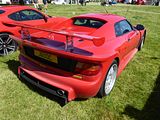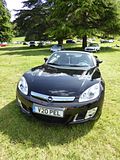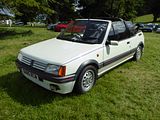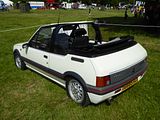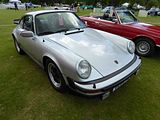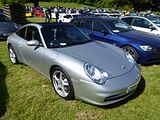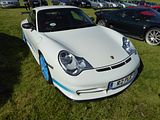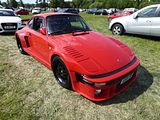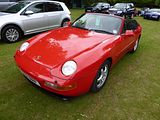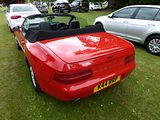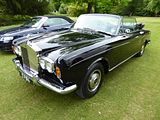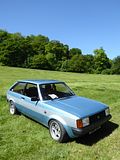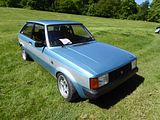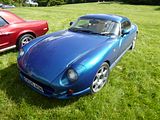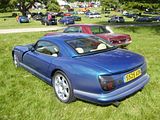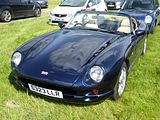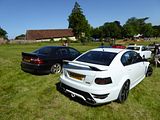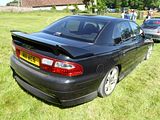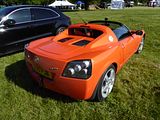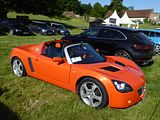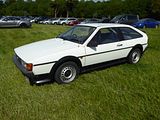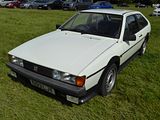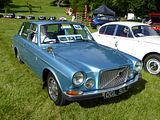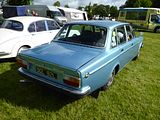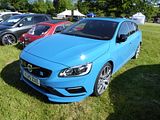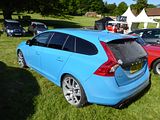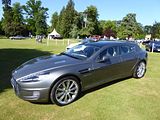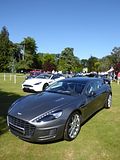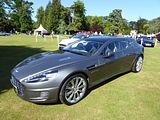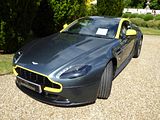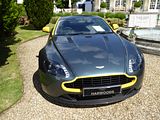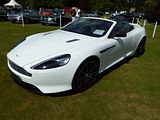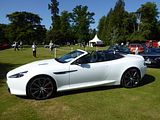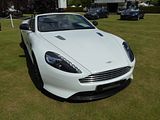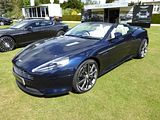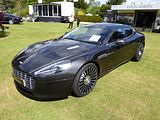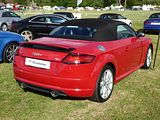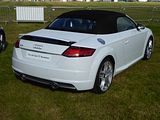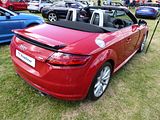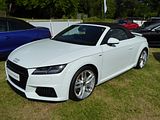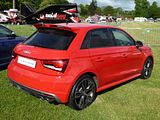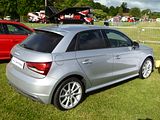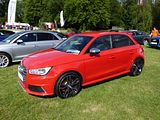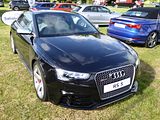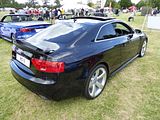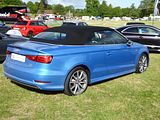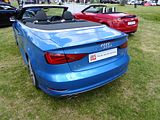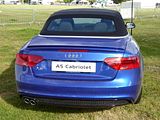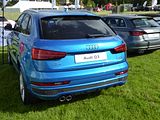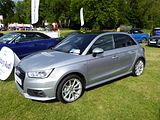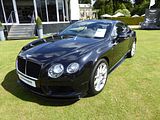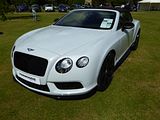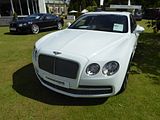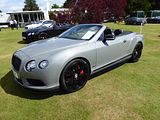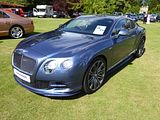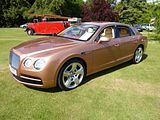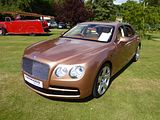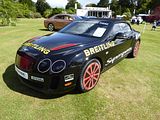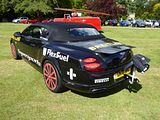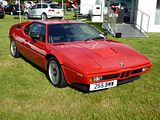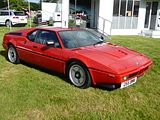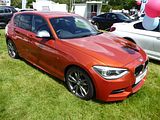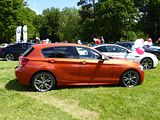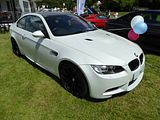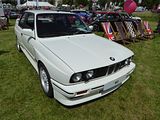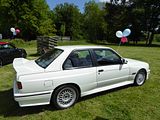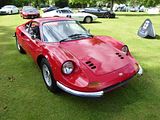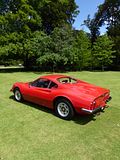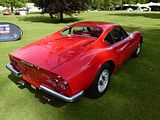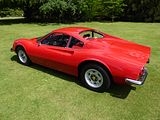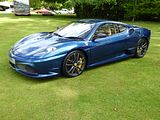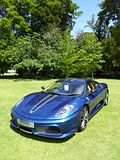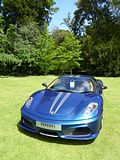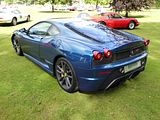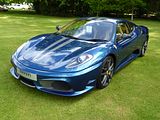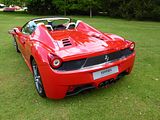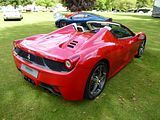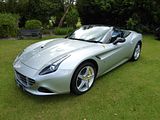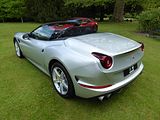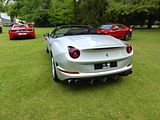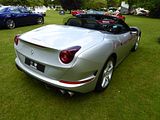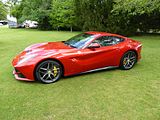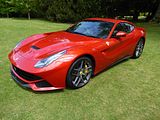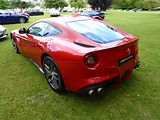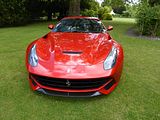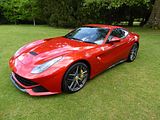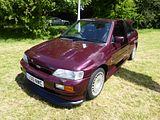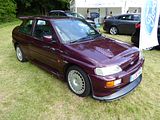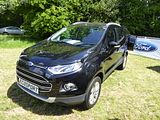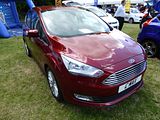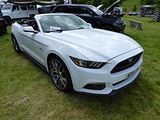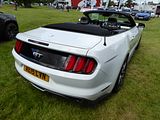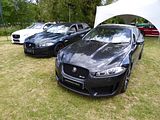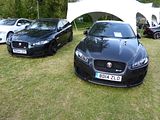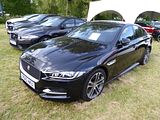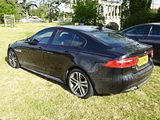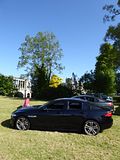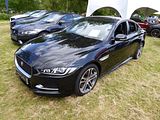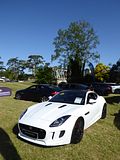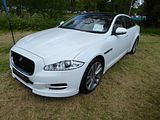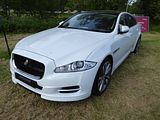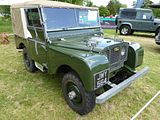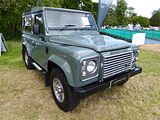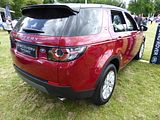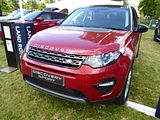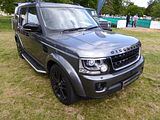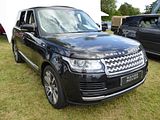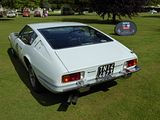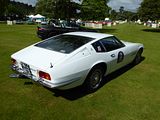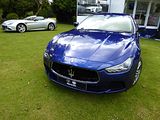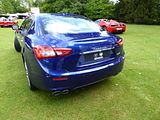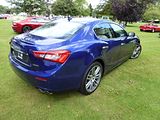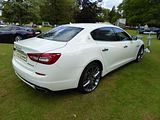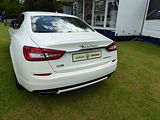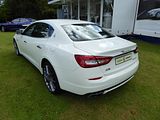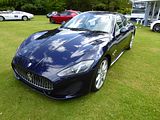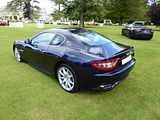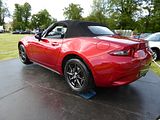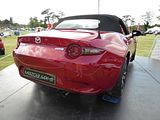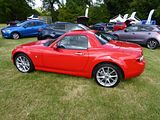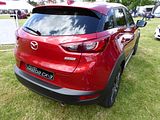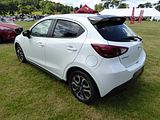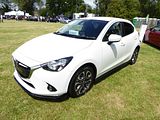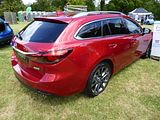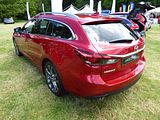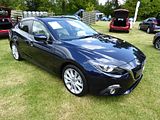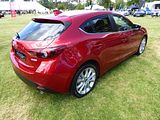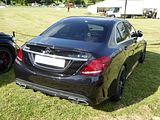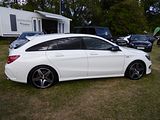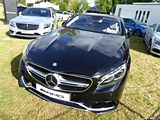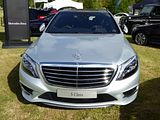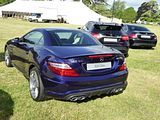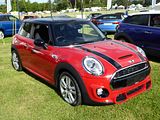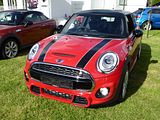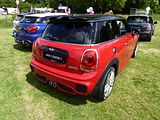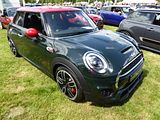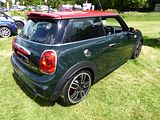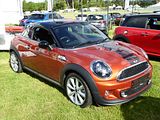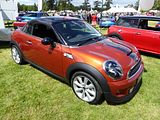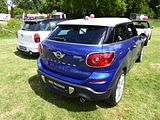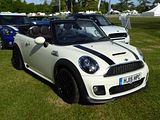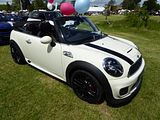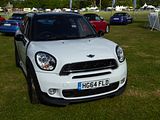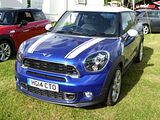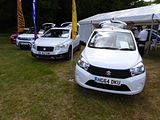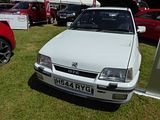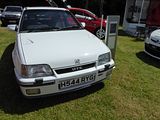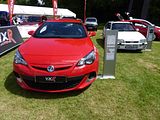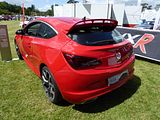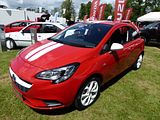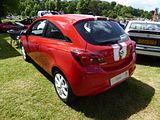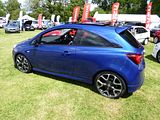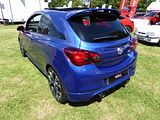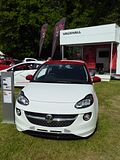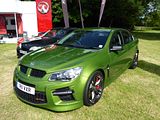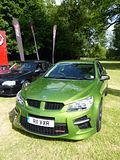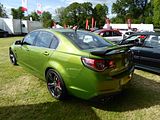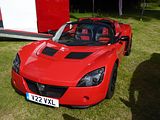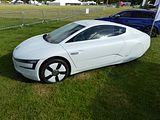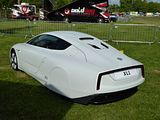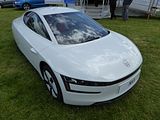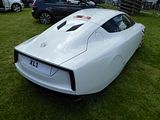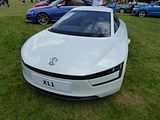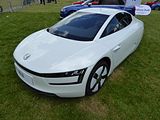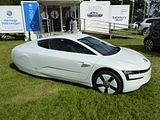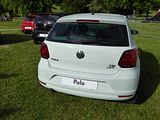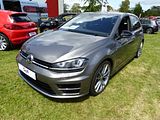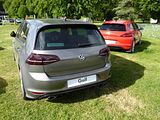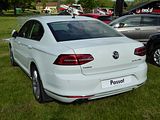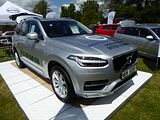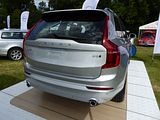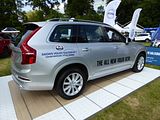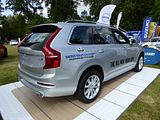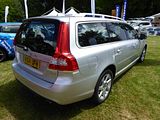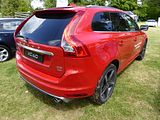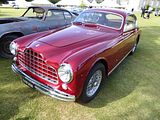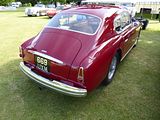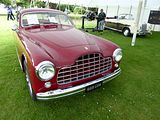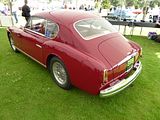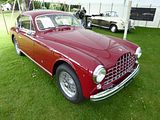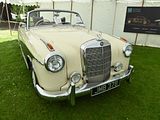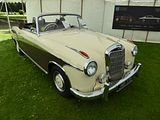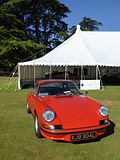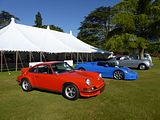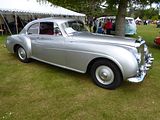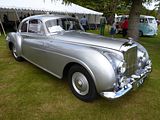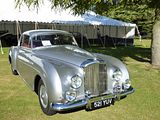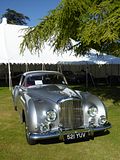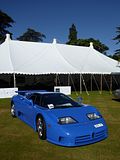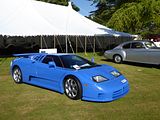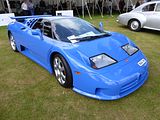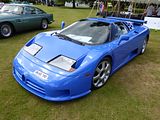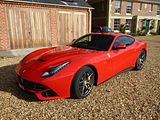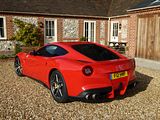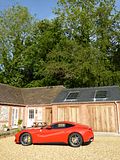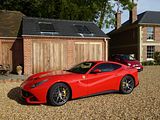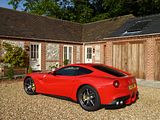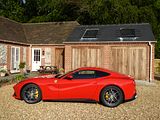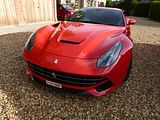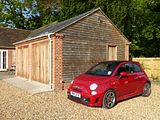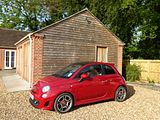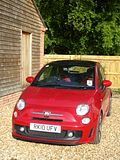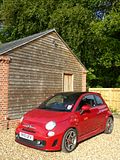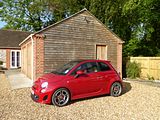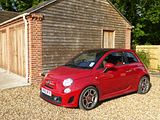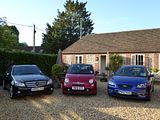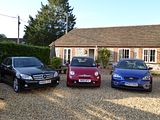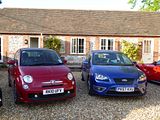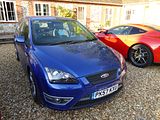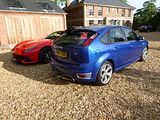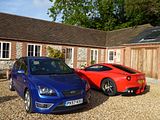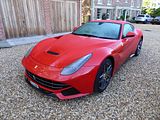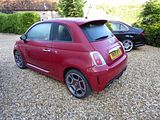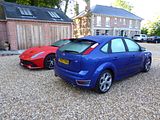During the course of a year, there are several events in the UK that take the Supercar as their theme, and all are very popular, allowing lots of people to get a glimpse of cars of their dreams, cars that they only usually see in pictures and read about in magazines, and maybe even have as posters in their (childhood?) bedrooms. Each event has its own following, and its own unique appeal, of course. One of the best, and most popular is the event organised for the last 6 years by Lord Pembroke, a veritable petrolhead of an enthusiast, and held at his residence, Wilton House, just outside Salisbury. The event has got bigger every year that it has been held, attracting a large number not just of supercars, but also several hypercars, and it has been one of the best chances of seeing more than one Pagani and Koenigsegg in the same place. Always looking for new ideas, for 2015, the event has expanded from a single day to a whole weekend, and the date moved from early August, to early June. It still clashes with plenty of other treats for the car enthusiast, but early June avoids the summer holiday season and is just as likely, or not, to have good weather. Having enjoyed this event for the last few years, I eagerly booked up for the whole weekend, as it was clear that with a “classic car” theme for the Saturday and a “supercar” theme for the Sunday, there would be lots to see that would be different over the two days. And so it proved. Although it is reported that more than 15,000 people came, the event never felt particularly busy, thanks in part to the fact that there is ample space around the House for cars and other attractions to be displayed. Visitors can go inside and see the house as well, a splendid edifice, occupied by the Pembrokes since 1540, and whilst I did not do this (did not have the time!), it would surely be worth including in the weekend, as it and the grounds are spectacular in their own right.
HIS LORDSHIP’s CARS
Lord Pembroke is an avid collector of cars, and has amassed a small fleet of some very nice machinery, of which his Veyron is perhaps the best known, but far from the only car worth seeing. The cars are usually housed in a mews on site, and visitors to the house when there is no special event on can include this on their tour. To make matters easy, for this event, they were all moved outside and parked up in a line near one of the main entrances, and what an array of desirable cars they proved to be:
Alfa Romeo 8C Competizione
This Ferrari 550 Maranello is a recent acquisition. Bought, it would seem, before prices go through the roof, which they almost certainly will do.
Ferrari 288 GTO
Honda S2000 Trackcar
Jaguar E Type 4.2 Roadster
Lamborghini Miura
Mercedes-Benz 300SL “Gullwing”
This is apparently the second R34 generation Nissan Skyline GT-R V-Spec that His Lordship has owned, and is a car in which he has covered a lot of miles. He is gradually restoring it back to original and pristine condition.
Nissan-Datsun 240Z
BUGATTI DISPLAY
To help to mark the 10th anniversary of the Veyron, Lord Pembroke set the challenge of getting a representative examples of every Type of Bugatti to the event. That was always going to be a tall order, given the very limited quantities of some models that were produced especially as the target list of cars included the legendary Royale. He cracked that one, as you will see and there was a spectacular assembly of 16 of Molsheim’s finest on the main lawn in front of the house, in two lines, with space for a number of Veyrons down the middle. Whilst some may have been disappointed that this area, which in the past has seen a number of hypercars in a roped off area was no to populated again, I thought that this was one of the highlights (of which there were many!) of the event.
The Type 13 was the first real Bugatti car. The Bugatti automobile had been pototyped as the Type 10 in Ettore Bugatti’s basement in 1908 and 1909 while he was chief engineer at Deutz Gasmotoren Fabrik in Cologne, Germany. The Type 10 used a monobloc straight-four engine of Ettore’s own design. it was an overhead cam unit with 2 valves per cylinder, highly advanced for the time. A very-undersquare design, it had a 60 mm bore and 100 mm stroke for a total of 1131 cc. This was attached to an open roadster body with solid axles front and rear. Leaf springs suspended the front with no suspension at all in the rear. Cables operated rear drum brakes. On ending his contract with Deutz, Ettore loaded his family into the Type 10 and headed to the Alsace region, then still part of the German Empire looking for a factory to begin producing cars of his own. After World War I, Alsace became a part of France again, of course. The prototype car was preserved and nicknamed “la baignoire” (“the bathtub”) by the staff at Molsheim in later years due to its shape. Ettore restored it in 1939 and repainted it an orange-red color, earning it a new nickname, “le homard” (“the lobster”). It was moved to Bordeaux for the duration of World War II and remained there for decades before falling into private ownership. Today, the car is in California in the hands of a private collector. Upon starting operations at his new factory in Molsheim, Bugatti refined his light shaft-driven car into the Type 13 racer. This included boring the engine out to 65 mm for a total of 1368 cc. A major advance was the 4-valve head Bugatti designed — one of the first of its type ever conceived. Power output with dual Zenith Carburettors reached 30 hp at 4500 rpm, more than adequate for the 660 lb (300 kg) car. Leaf springs were now fitted all around, and the car rode on a roughly 79 in wheelbase. The new company produced five examples in 1910, and entered the French Grand Prix at Le Mans in 1911. The tiny Bugatti looked out of place at the race, but calmly took second place after seven hours of racing. World War I caused production to halt in the disputed region. Ettore took two completed Type 13 cars with him to Milan for the duration of the war, leaving the parts for three more buried near the factory. After the war, Bugatti returned, unearthed the parts, and prepared five Type 13s for racing. By the time production of the model ceased in 1920, 435 examples had been produced and the model had also formed the basis of the later Types 15, 17, 22, and 23. Most of the road cars used an 8-valve engine, though five Type 13 racers had 16-valve heads, one of the first ever produced. The road cars became known as “pur-sang” (“thoroughbred”) in keeping with Ettore Bugatti’s feelings for his designs. The car was brought back after World War I with multi-valve engines to bring fame to the marque at Brescia, which is why the model is often referred to as a Brescia Bugatti. The production “Brescia Tourer” also brought in much-needed cash.
Developed from the more familiar Type 13 Brescia model, this chain-driven Bugatti Type 18 was Ettore’s personal car. Despite its relatively small size, it has a 5027cc four cylinder engine packed under bonnet. One of just 6 or 7 such cars built between 1912 and 1914, it is one of just three that have survived. It was a very advanced car for the time, with an overhead cam engine with 3 valves per cylinder engine. With a 100mm bore and 160mm stroke, it would rev to 2400rpm, which was enough to give it a top speed of 80 mph. Ettore raced the car, with its best result being a victory on the 1912 Mont Ventoux hillclimb.
This is a Type 22. an update from the Type 15, first seen in 1913. It featured a larger roadgoing body, an oval radiator, and quarter-circle springs. The 1496cc engine generated 45 bhp.
This is the ex Hamish Moffet, DB Madeley Type 23 Crossley Brescia. Chassis CM1614, engine number 16. This is believed to be the only surviving complete example of the 25 Crossley assembled Brescias.
Perhaps the best known Bugatti model of all, the Type 35 was offered in three different versions, called 35, 35B and 35C. Little is known about the early history of this particular Type 35B, which bears Frame number 369. Bugatti records would indicate a construction date of 1927. The rolling chassis was brought to England during the 1950s. Rebuilding continued on and off until 1978 when Tula Engineering finished the work ready for the 1978 racing season. The car has competed every since and is considered one of the fastest T35Bs. The car has been allocated the chassis number BOC 007. It currently belongs to one Nick Mason.
Proving that if you have the right connections, you can get even some very rare cars to your event, and that can include one of the handful of Type 41 Royale cars made, then here was the evidence. Dating from 1926, this was the prototype. The body was changed four times in period, first to a Convertible, then to a Coupe de Ville, to a Saloon and back to a Coupe de Ville. By this point, Bugatti was simply trying to sell the car, and then while he was behind the wheel, he had a bad accident in it, and there was no remaining body left. The badly damaged chassis, front and rear axles were found by a Dutch specialist in 1995, who made the decision to restore it in the form of the prototype, which meant recreating a body from a Packard of the era, which Bugatti had fitted first of all, so as to test the prototype. It took four specialists in Britain, Germany and the Netherlands seven years to complete the restoration, with Tom Dark matching the mechanical components and Greg Morgan overseeing the whole project. This was the first time the car had been seen in the UK.
Replacing the Type 38, was the Type 44. Approximately 1095 examples were built, of which only about 10% remain. Power came from a straight eight 3.0 litre engine and the cars had a wide variety of different bodies fitted to them.
The mighty Type 54 was launched in 1931. Designed to fend off the growing challenge from Alfa Romeo and Maserati, Ettore sought greater speed by fitting the new machine with the largest capacity engine seen in GP cars of the era, a 4.9 litre supercharged straight 9 engine. On display was the car on which Achille Varzi set fastest lap and finished in its Grand Prix debut at Monza that year. Just 4 of these models remain.
This Type 57SC with Gangloff body will be familiar to visitors to Prescott, as the car is frequently displayed at events there, and it “lives” at the Bugatti Trust museum on site there. The Type 57 was launched in 1934 and stayed in production for 6 years during which time 710 examples were made. A number of different versions were produced, with bodies by various coachbuilders, of which the Atalante and the Galibier styles are perhaps the best known. The original Type 57 was a touring car model with a 3,257 cc 8 cylinder engine from the Type 59 Grand Prix cars, producing 135 hp. Top speed was 95 miles per hour . In quest for more power and hence speed, Bugatti added a supercharger, to create the 57S/SC models. The “S” stood for “surbaissé” (“lowered”). It included a v-shaped dip at the bottom of the radiator and mesh grilles on either side of the engine compartment. Lowering the car was a major undertaking. The rear axle now passed through the rear frame rather than riding under it, and a dry-sump lubrication system was required to fit the engine under the new low hood. The 57S had a nearly-independent suspension in front, though Ettore despised that notion. Just two supercharged cars were originally built but many were returned to the factory Molsheim for the installation of a supercharger, These cars are now much sought after and a rediscovered Type 57 sold for €3.4 million at auction in 2009 in Paris. This stunning example is in fact a reconstruction of the original Gangloff Coupe built according to the original sketches on a Type 101 chassis and powered by an engine from a Type 57 Atlante, so although not an original car, it is still all Bugatti and still worth a Kings ransom
This is the 1938 Type 59/50 which made its debut in this form at the Cork GP. Originally appearing in 1935 at Montlhery, the car was fitted with an engine from a Type 54 for this debut in Cork. It is still a very original car nearly 80 years later.
Although the Second World War interrupted production of Bugattis, as it did with all European cars, most manufacturers were not completely idle, undertaking design work in readiness for when production could resume. Bugatti was no exception, and in 1943, work started on what was planned to be the Type 73. Progress was slow, and reduced further by the death of Ettore. That meant that just 1 body, 3 engines were made, resulting on one complete example of the Type 73C in 1947. Others were later assembled.
It was a long time before we would see another “production” with the Bugatti badge on it. That came on the 15 September 1991, when the EB110 was unveiled in both Versailles and in front of the Grande Arche de la Défense in Paris, exactly 110 years after Ettore Bugatti’s birth, hence the name of the car. Styled by renowned designer Marcello Gandind, with a 60-valve, quad-turbo V12 powering all four wheels through a six-speed gearbox, the 3499 cc engine generated 560 PS at 8000 rpm, giving a quoted acceleration to 100 km/h time of 3.2 seconds, and a theoretical top speed of 213 mph. The car used a double wishbone suspension, with the chassis built by Aérospatiale, an aircraft company, and made from carbon fibre. Equipped with Gandini’s famous lifting scissor doors, it had a glass engine cover that provided a view of the V12 engine along with a speed-sensitive electronic rear wing that can be raised at the flick of a switch. In 1992, a lighter and more powerful model with 612 PS at 8250 rpm, the EB110 SS (SuperSport) was introduced. This version was said to be capable of 216 mph and 0-100 km/h (62 mph) in 3.2 seconds. Early in 1994, Formula One driver Michael Schumacher purchased a yellow EB 110 SS, giving the company a great deal of publicity. Schumacher retained his car until 2003. Hard times hit the company in 1995 and, as result of chairman Artioli’s over-ambitious purchase of Lotus in addition to the company’s quest to develop the EB112 four door car, the company was bankrupt. Dauer Racing GmbH of Nuremberg, Germany, bought the semi-finished EB 110 cars in the assembly plant plus the parts inventory through the bankruptcy trustee. The remaining chassis and a version of the engine were later developed by B Engineering into their Edonis sports car. Just 139 of these cars were built, making them far rarer than what would follow.
Whilst the older Bugatti cars on show were very splendid, it was the line of Veyrons parked down the middle which were the real stars and a huge crowd puller It is not often you get to see 4 or 5 of these cars together, but that was the case here. Lord Pembroke’s car, which has now covered more than 20,000 miles was among them, with the wrap that it featured for a couple of years now removed, and also in the collection was a SuperSport and a Pur Sang.
CONCOURS CARS
A feature of both days of the event was a Concours of cars parked up individually on the main lawns to the west of the house. Each car was carefully selected for its elegance and significance and was worth seeing in it own right. That every car was parked up, and with a couple of exceptions without any ropes or barriers around them, made it particularly easy to get a good view of some splendid machinery.
AC Cobra 427
Alfa Romeo 8C 2300 Touring
Alfa Romeo 8C 2300 Monza
This Alfa Romeo SZ1 Coda Tronca is the latest discovery of renowned collector of Italian cars, Correado Lopresto. This car is the very first of the Zagato bodied long-tailed SZ cars, where the extra length was added in the name of better aerodynamics. This aluminium-bodied prototype was created by Elio Zagato and Ercole Spada, based on an Alfa Giulietta, and initially featured a long flowing tail which was gradually shortened following speed testing on the Milan to Bergamo autostrada, and welding lines under the car in three places indicate that different iterations were trialled. With the shorter tail creating a vaccuum effect to the rear at high speed, the car could achieve a 20 km/h higher top speed, revealed in start and end times in the two cities. The revised body work was productionised and fitted to the last 30 of the Sport Zagato Giulietta cars. Other aerodynamic changes included narrowing the body, rearranging the front air intakes to reduce frontal drag and lowering the roof, and this example does not feature the trademark Zagato “double bubble” roof. This car, believed lost of decades, was recently found in a barn in the United States.
Allard J2
Alvis TD Convertible
Aston Martin DB3S
Aston Martin DB4
Aston Martin DB6
Austin Seven
Bentley 4.5 litre
This Bentley Continental “LaSarthe” is becoming quite well known, appearing at just about every major show you can think of, following a debut in 2014 when no-one really knew what it was. A feature in Octane magazine a few months ago no doubt filled in some of the gaps, too. It combines a modern body with the underpinnings of a fully restored early 1950s Bentley R Type.The new aluminium bodywork is some 300 lbs lighter than that of an original R-Type Continental Fastback, so coupled with its maker Bensport’s engine and exhaust developments, it is sure to go as well as it looks. The handling also benefits significantly from detailed chassis modification, and uprated suspension, brakes and cooling systems also improve its usability in modern urban traffic. For now, it remains a one off, but if you wave the appropriate quantity of monies around, BenSport Ltd could be persuaded to build one for you as well.
Bentley Speed Eight le Mans car
This is an example of the first Bristol, the 400. Given the general rarity of any cars with of the marque, it is quite surprising to learn that around 700 of these were were produced, and many remain around today. The genesis of this car is that HJ Aldington, a director of the Bristol Aeroplane Company (BAC) used his British Army connections, in affiliation with Frazer Nash, the pre-war concessionaire for BMW cars in the UK, to visit Munich several times in 1945, to investigate plans for making cars. BAC set up a car division and bought a controlling stake in Frazer Nash, It was only in 1960 when the original BAC Company merged with several other aircraft manufacturers to form the British Aircraft Company, which later became British Aerospace, that Bristol Cars became a separate entity. By this time, the manufacturing base at Filton, in Bristol, deeply embedded in what these days is Airbus was established. The fist car, the 400 was derived from pre-war BMW products, with a body based on the 327, and the engine and chassis having their origins in the 326 models, even retaining a variant of BMW’s trademark grille design.
Replacements for the distinctive 403 model came in the guise of two different numbers and three cars, the 404 and 405. The two door Coupe 404 was first to market, launched in 1953, two years before the 4 door saloon and open topped 405 cars. The 404 was a very short wheelbased car, at 8 feet, as against 9 feet 6 inches for the 405. It incorporated the same changes as were to be found in the 405, with a higher compression and more powerful version of the familiar 6 cylinder 2 litre engine. Just 52 of them were made.
DeLorean DMC12 “Back to the Future”
1958 Ferrari Fantuzzi Spider
This Ferrari 250 dates from 1959, and is known as an “interim”, as it comes between the SWB and the GTO. Mechanically it is very similar to the GTO, and it has a slightly longer wheelbase than an SWB, hence the larger B/C pillar with the three-quarter window. This particular car came fourth at Le Mans in 1959 with the North American Racing Team, raced by Andre Pilette and George Arents. The car has not been seen in public for a long time, having been consigned to a museum for several decades. It is about to be given a full restoration.
This Ferrari 250 GT LWB is one just 6 to be have been bodied by renowned Italian coachbuilder Zagato. Converted in the 1990s by Elio Zagato himself, the car is replete with lots of amazing details and of course features the trademark “double bubble” roof of all Zagato cars. Maintained by DK Engineering for many years, they are now selling it. Needless to say, price is “on application”, and it will not be cheap!
This was another opportunity to see the 1961 Ferrari 250GT California Spider that had been at the London ExCel Classic Car event back in January. Once owner by Chris Evans and James Coburn, the car is still for sale at Joe Macari. Very lovely, but you will need a lot – and I do mean “a lot” of money – for it.
A little cheaper would be this Ferrari 250GT Lusso, which is currently up for sale at DK Engineering.
Ferrari 275 GTS
Having seen this Ferrari 275 GTB in the VIP car park on the Saturday, I noted that it was in the main concours by the Sunday, and rightly so.
I first saw this Ferrari 330 Shooting Brake at the Brooklands Auto Italia event in May, and thought that I probably would not get the chance to see it again. And then here it was once more. A special one-off model based on the 330 GT, this Shooting Brake was designed by Vignale, the last Ferrari that this styling house produced, and indeed the last car produced by Fredo Vignale before he passed away in 1969. Car number 7963 was originally built in 1965 as a left-hand-drive American market model and shipped to Luigi Chinetti Motors in Greenwich, Connecticut. Finished in red with beige interior, it rode on the standard perforated alloy wheels. Sold new to an American owner named Desy, by 1967 it was in the hands of Luigi Chinetti Jr, son of the American Ferrari importer. Coco, as he was known, had an eye for design and had grown up around everything Ferrari. With the collaboration of commercial artist Bob Peak, he came up with a concept for a completely new sport wagon design to be built on the 330 GT 2+2 chassis. To put the design into the metal, the pair contracted with Alfredo Vignale, who had bodied many a Ferrari in the days before Pininfarina became the exclusive carrozzerie for the marque from Maranello. When the 330 wagon appeared, there wasn’t a panel in common with the donor body. The prow was sharp and swept up slightly over the front wheels, while a pronounced beltline crease swept from behind the front wheels all the way aft. Vignale displayed the unusual Ferrari on his stand at the 50th Turin Motor Show, before it was returned to Coco Chinetti in Connecticut. It turned up several years later in the Philadelphia area and by 1977 it had migrated to the Northern Virginia and Ed Waterman’s Thoroughbred Motorcars. By the 1990s it was in Paris with Jean-Claude Paturau, who displayed it at the Louis Vuitton Concours d’Elegance at Bagatelle in September 1996. Withe 13,000 miles on the odometer, it came up for auction in 2008, with a guide price of $500 – 600,000 but did not sell. Later it was snapped up by a certain Jamiroquai, but is now for sale. The car is in exceptional condition, resplendent in its original colour Verde Metalizzatto , though the original Gold roof sections were repainted at Jay Kay’s request. The original Campagnolo alloy wheels are unmarked. The unique Glass Hatch-back section allows access to the cavernous lather lined boot. The Tan interior, Nardi steering wheel and dash are faultless and include badging on the passenger side from Vignale saying ‘Carrozzeria Vignale Examplare Unique’, another feature unique to this car. The car and its ownership history have been well documented in many Ferrari publications, and it has been seen at exclusive events such as Salon Prive in recent years.
I’ve been a huge fan of the 365 GTB/4 “Daytona” since childhood, when this car, with its quoted top speed of 174 mph from its V12 engine was a winner in Top Trumps. You don’t see them that often, so to come across one is always a treat, and this was a particularly nice example . The first cars had headlights presented behind a body width plexiglass front, but this design featured was soon abandoned in favour of the pop up headlights. Launched at the 1968 Paris Show, the car was produced for just 5 years. The generally accepted total number of Daytonas from the Ferrari club historians is 1,406 over the life of the model. This figure includes 158 right-hand-drive coupés, 122 factory-made Spyders (of which 7 are right hand drive), and 15 competition cars in three series with modified lightweight bodies and in various degrees of engine tune. All bodies except the first Pininfarina prototype were produced by Scaglietti .
Look closely at the front of this Ferrari LaFerrari, and you will see the towing eye protruding from the bumper. I can only guess that the car had been towed on site, which would seem a little surprising. Needless to say, the sight of a LaFerrari, with no barriers around it was like a magnet to most event attendees, and the photographer had to be patient to get these pictures!
Fiat-Abarth 595SS
Ford GT40 x 2
Gordini Sports
Guy Fire Engine
Invicta S Type Low Chassis
This fabulous 1967 Iso Grifo belonging to Andrew Yaras was awarded the top prize of “Best Car in Show”. The Grifo – Italian for ‘Griffin’, a mythical creature part eagle, part lion, that would devour men and their (prancing) horses – is a lavish Italian ’60s Grand Tourer with a powerful American V8 hiding under the bonnet. One of few remaining cars with the two-speed Powerglide gearbox, the driving experience is ‘completely effortless’, making it great for long-distance driving. The current owner has taken it to Le Mans a couple of times, and also all the way to Northern Italy, and notes that if you kick down at anything above 50 or 60mph, the acceleration is phenomenal. This is the sole right-hand-drive Iso Grifo (of which there are believed to have been fewer than 30 built) with a factory sunroof. The first owner of this particular car had a famous restaurant on the King’s Road in the ’60s, frequented by celebrities, including the Rolling Stones and the car would have been a common sight cruising up and down there in 1967. Apparently the owner then disappeared while on a business trip in America. The Grifo was simply left on the King’s Road, half on the pavement, before eventually disappearing. Whether this is true or not, it makes for a good story. Yaras bought the car at auction 25 years ago. Often seen in brighter colours, the judges particularly loved the understated dark green hue of this car, resplendent after a bare-metal respray two years ago. Its originality, something Yaras is keen to preserve, is otherwise especially evident; such as with those beautifully patinated cast-alloy wheels. Look inside, and you’ll see that one of the switches reads ‘Ejector Seat’ – “someone with a sense of humour,” quips Yaras. That’ll be something to do with the sunroof, we suspect.
Jaguar C Type
Jaguar E Type Lightweight
Jaguar E Type
Jaguar E Type V12 Series 3 Roadster
This rather fabulous Lamborghini Espada belongs to a certain Harry Metcalfe
Maudsley
McLaren F1 GTR
Mercedes 300SC
This 1928 Mercedes Benz 36/220 S Type, which was one of the first cars to appear after the amalgamation of Daimler and Benz in 1926, lives in the National Motor Museum at Beaulieu. Designed by Dr Ferdinand Porsche, the supercharged S Type, with a 6 cylinder 6.7 litre engine, giving it a top speed of 110 mph, has since become one of the most desirable of all vintage sports cars. This particular 1928 example, YX5964, was once owned by Peter Ustinov and has recently been restored by the museum to its original condition. Only 146 examples of this model were made.
Oldest car at the event was this 1902 Panhard et Levassor
Porsche 911 Carrera RS
This 1936 Voisin C28 Chancellerie Berline Aerodynamique is a great example of the spectacular cars that were produced by the French concern, Avions Voisin. The marque was founded by Gabriel B. Voisin, an aviation pioneer and manufacturer, who in 1919 started producing cars using Knight-type sleeve valve engines at Issy-les-Moulineaux, an industrial suburb to the southwest of Paris. Former student of the Fine Arts School of Lyon and enthusiast for all things mechanical since his childhood, Voisin’s uncompromisingly individual designs made extensive use of light alloys, especially aluminium. One of the company’s most striking early designs was the Laboratoire Grand Prix car of 1923; one of the first cars ever to use monocoque chassis construction, and utilising small radiator-mounted propeller to drive the cooling pump. The characteristic Voisin style of ‘rational’ coachwork he developed in conjunction with his collaborator André Noel. Noel prioritized lightness, central weight distribution, capacious luggage boxes and distinctively angular lines. The C28 Voisin was in production between October 1935 and mid 1937 and was the last model of which the remarkable founder of the marque, Gabriel Voisin, would have full control before spiralling costs of production and a downturn in the economy provoked a takeover which changed Avions Voisin dramatically. Targeted as a direct competitor to the Type 57 Bugatti, the C28 featured a 3.3 litre, in line, six-cylinder sleeve valve engine, enlarged from the 3 litre of its C25 predecessor, with a four speed Cotal electromagnetic gearbox. Coachwork, as ever with Voisin, was beautifully designed with the artistic influences of the Art Deco period enhanced by great attention to detail and originality of thought. It also incorporated lightweight construction techniques learnt by Gabriel from his earlier work on aircraft. The Constructor offered five bodywork styles, the fastback Aerodyne and Aerosport, and three streamlined sedans, the two door Cimier and two four-door models, the Clairire and Chancellerie. The principal difference between the four door cars was the treatment of the spare wheel, which on the Chancellerie was stored out of sight inside the boot of the car. By the time production ceased in 1937 approximately forty C28 chassis had been built by the factory, of which a handful received coachwork by non-factory bespoke coachbuilders. The majority of cars received the exotic Voisin designed coachwork. There are now only eight surviving C28 examples worldwide of which four are of the Clairire or Chancellerie style. It is the details which add to the charm of these models, and this one is no exception, from the busy elaborate dashboard equipped with a multitude of Jaeger instrumentation, to the cast aluminium bodywork trim and exquisite door handles, and then there is the grille mascot, which would of course give today’s legislators hear palpitations. This car, which has been presented for sale recently, from a private collection, was ordered new with the additional option of the full width opening roof and scuttle ventilation and would have cost its first owner over 85,000 Francs, 25% more than a Bugatti Type 57. The car was discovered in the 1980s in France and subsequently underwent a thorough restoration of both cosmetics and mechanics.
Willys Jeep
SPECIAL DISPLAYS
ASTON MARTIN
Displayed under an awning, with absolutely no signage to tell anyone what it is, was the Aston Martin DP100, a car deigned for a virtual rather than a physical reality. First seen in 2014, the DP00 was created for Polyphony, the makers of the Gran Turismo computer game, as one of 28 cars commissioned by GT6’s creator, Kazunori Yamauchi, who invited a small group of car companies and “cool brands” to create new products and launch them within the game over the following 12 months. to mark Gran Turismo’s 15th anniversary. Aston Martin took the task seriously, with a crack design team spending a hectic six months creating the radical machine, even though it will never carry a passenger or turn a wheel in anger. Designed on the proverbial blank sheet of paper, the car will remain a virtual-only GT racer, though as well as the virtual car, Aston Martin has created a full-size 3D display model to stress that this is far from being a frivolous project. DP-100 is intended as a proper GT race car, short-nosed and low, with a cab-forward layout to give maximum space for a large V12-based powertrain behind the driver. In the flesh it looks imposing but compact; nowhere near as large as a full-size Lamborghini for instance. On the upper flanks there’s well-defined chine-line each side, running from the rear of each front wheel, upward and rearward to define the car’s proportions and especially its prominent rear haunches, which are almost architectural in form. The car’s styling refers clearly to the Aston Martin One-77 supercar (via a well-defined chine-line that runs around the car and defines its stance), to the recent CC100 anniversary car and even to Aston’s revolutionary mid-engined Bulldog concept of the early 1980s which was designed by the late William Towns, and which had the same sort of radically ‘waisted’ body style. Race-bred aerodynamics contribute much to DP-100’s overall look, but designers have taken trouble to avoid crudely added wings or cut holes to relieve high pressure areas. In key places air is ducted straight through the car — to benefit of engine and downforce. The central front air intake has an unmissable Aston grille-shape, flanked by a pair of ducts that carry air straight through the body to exit across a very large, Le Mans-style diffuser. The car was designed according to a philosophy called RaceCraft, the chief exterior designer Miles Nurnberger said at launch, which supposedly combines the no-nonsense requirements of a race car with the kind of beauty and sophistication you find on a really well-crafted road car. The design is fully detailed, with a plausible chassis and a working suspension, a fully equipped cabin and even a complete underbonnet layout, but to see everything that has been created, you have to play the game. The cabin is enclosed by forward-opening ‘swallow’ doors, plausibly designed because they have to open in the GT6 game. The interior takes a lot of influence from the open, spartan CC100 concept, which uses exposed carbonfibre surfaces in many places. Over DP-100’s front wheel arches (which in race cars are notorious high pressure areas) the designers have provided ducts for the outflow of air, but disguised them brilliantly so that the car’s proportions are not interrupted. The wheels themselves are a tour-de-force; they are fitted with hinged carbonfibre blades, looking a little like jet engine intake compressor blades, which bend outward under the wheel’s rotational forces to create a smooth disc at high speed, for lowest aerodynamic drag. The wheels fit closely into the plainly styled wheel arches, and wear 255/40x20in Michelins in front, and 295/40sx20s behind. The colour scheme — a kind of metallic China-white on the left and right extremities, with a purple expanse on the nose, the two major colour patches separated by a line of luminous orange — may not describe very well, but it looks amazing in the flesh, doing what so much of the restr of the car does, suggesting a life in racing but doing it with greater-than-usual design sophisticated. Nurnberger reckons his favourite DP-100 features are a tail light treatment made up of an exotic array of light-sticks (they look more like something out of a museum of modern art) a pair of tiny headlights each buried in the entrance to matching NACA ducts on the short nose, that gather air for other uses, a pair of extravagantly curved pieces that define the car’s upper proportions (Nurnberger calls them floating cant rails). Kazanori Yamauchi, who watched DP-100 evolve, says he’s delighted with the result: “When I first came face to face with this car I was at a loss for words. It is is clean and classy, and also very emotional. Here was this future Aston Martin in front of me, so detailed it could be released on the market pretty much as it.” Most of what you see here is pie-in-the-sky concept car stuff. But those rear lights will influence the next generation of Aston Martins, echoing the brand’s famous badge in their C-shaped sculpture.
CASTROL
Castrol were one of the main sponsors of the event. As well as large hospitality area for their invited guests (of which I was not one), off to the east of the main part of the event, they had a large marquee area, covering a variety of cars and displays, with yet more interesting vehicles parked out in front of it.
Key vehicle in the marquee itself was the Bloodhound. Under development for years, this is getting better and better known, which is one of the reason why it has featured at so many events over time. As well as the attempt on the World Land Speed Record, which will take place only when the team are confident of success, and the conditions are right, in Namibia, where it will be undertaken, the Bloodhound project has a secondary purpose, which is to try to enthuse young children in engineering and technology, as it is clear that we need far more young people to enter these professions than we currently manage to achieve.
This life-sized replica of a Veyron was covered in over 400 old oil bottles.
Jaguar XJ220
Jaguar XJ13
This is the 1988 le Mans winning Jaguar XJR9
Latest Jaguar F Type
Ford Fiesta S2000 Rally car
Audi RS5 DTM
Chevrolet Firenza
FORMULA 1 CARS
A special display on the east lawn brought together two iconic Formula 1 cars from an era of particularly close racing and rivalry between two great drivers: Ayrton Senna and Alain Prost. Commemorating 25 years since their epic first corner clash at the Japanese Grand Prix which handed Senna the Formula 1 World Championship that year, we could see Senna’s V10 engined McLaren MP42 as well as Prost’s Ferrari 641/2.
LE MANS CARS
A nice pairing of the legendary Porsche 956 comprised an ex Bell/Bellof Rothmans liveried car with the Jean Rondeau and John Paul Jr Swap Shop car that finished second at this event in 1984.
McLAREN
McLaren have been staunch supporters of the event for a while now, and the factory has always brought along an interesting assembly of cars, along with a knowledgeable staff to answer questions., Last year they had an example of the legendary F1 parked up alongside the latest P1 car, so topping that was always going to be difficult. Neither of those were here this time, but what they did have to show was just as interesting. This was the first time that there were examples of the three-tier McLaren range that was announced earlier in the year, with some of the cars on show making their UK debuts.
Following the global reveal of the 570S Coupé at the New York Auto Show last month, the first and most powerful model in the newly announced Sports Series was being seen on UK soil for the first time. The mid-engine sportscar features the lightweight carbon fibre MonoCell II chassis, and a highly efficient 3.8-litre twin turbo V8 engine generating 562bhp and 443lb/ft of torque. Although the model has been conceived with a greater focus on day-to-day usability and refinement, but it is still very much a pure McLaren, boasting a class-leading power-to-weight ratio of 434PS per tonne, and electrifying performance. The 570S Coupé accelerates from 0 to 100km/h in just 3.2 seconds, reaches 200km/h (124mph) in 9.5 seconds, and on to a top speed of 204mph. Pricing for the 570S Coupé, which goes on sale later this year, starts at £143,250.
The limited edition 675LT first seen at the Geneva Show in March, was one of two Super Series models on display, alongside the 650S Spider. The 675LT generates, as the name implies, 675PS (666bhp) and is the lightest and most track-focused, yet road legal, model in the Super Series. Production of the coupé-only model is strictly limited to 500 examples worldwide, and they have all been sold. With a clear focus on light weight, optimised aerodynamics, increased power, track-focused dynamics and driver engagement, the coupé-only model re-establishes the ‘Longtail’ heritage. With a top speed of 330km/h (205mph), the 675LT accelerates to 100km/h (62mph) from standstill in 2.9 seconds, and hits 200km/h (124mph) in just 7.9 seconds.
The 650S is the core model in the Super Series, designed and developed to give the enthusiast driver the ultimate in luxury, engagement and excitement. Fitted with the award-winning 3.8-litre twin turbo V8 engine producing 650PS (641bhp) and 678Nm (500lb ft) of torque, it is a no compromise open-top high performance supercar with optimised levels of performance, handling and driver enjoyment. The secret of its success is its carbon fibre MonoCell chassis, which needs no extra strengthening to provide the necessary rigidity or safety when developing a convertible. This keeps any weight increase to a minimum, meaning the McLaren 650S Spider offers all the enjoyment and driver appeal of the fixed-roof sibling – but with the added appeal of roof-down driving. The 650S Spider is fitted with an electrically retractable hard top, which can be automatically raised or lowered on the move in less than 17 seconds.
Completing the line-up from McLaren was the P1 GTR, representing the Ultimate Series – the most exclusive and definitive McLaren range. The track-dedicated model is the most powerful built by McLaren to-date, fitted with a 1,000PS (986bhp) powertrain comprising a highly efficient 3.8-litre V8 twin turbo petrol engine generating 800PS (789bhp) together with an integrated lightweight electric motor producing an additional 200PS (197bhp) of instant power. Drivers will also join the world’s most exclusive McLaren ownership programme, and gain unique access to more than 50 years of race winning knowledge and expertise. With access to the world within the McLaren Technology Centre, each driver will have an unparalleled, and completely unique, experience. As race winners and world champions have before them, each driver will embark on a bespoke driver programme designed to hone and optimise driving skills, and learn how to get the best of themselves and the car.
Not part of the factory display, and indeed tucked away at one of the lawns, and likely to be missed by many visitors was an example of the F1 GTR.
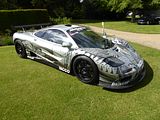
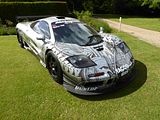

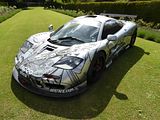
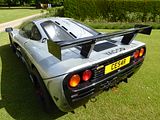
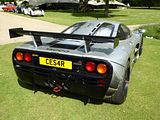
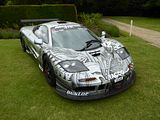
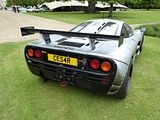
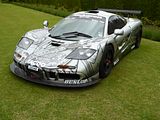
POP BANG COLOUR
Ian Cook has made quite a name for himself now, producing car-related paintings where he transfers the paint to the canvas using the wheels of radio controlled cars rather than conventional brushes. He always attracts quite a crowd around his demonstrations. Luckily he confines the mess – and he does get quite into quite a state – to himself. The trademark style of the end result has been applied to this Morgan Three Wheeler which was parked up by his work area.
TRACTION ENGINES
Once the workhorses of the road and field, Traction Engines now attract large crowds as we marvel at how the beasts introduced an element of mechanisation into what previously been a manual and horse powered world. There was an impressive collection of these machines lined up, most of them in steam, and one of them performing demos during the day as to how it could be used to chop wood, with an impressive amount of lumber processed by the end of each day.
TRACTORS
There was also a long line of historic tractors on show. Many of the earlier ones looked particularly small if you compare them to the massive beasts which are sold these days. See here the old Ferguson which enjoyed a new burst of popularity when Tony Archer, in the long running Radio 4 program, decided to restore one, as well as Massey Fergusons and Fordsons from the 1950s and 1960s. A reminder of a bygone age. I remember some of these from my Uncle’s farm as he kept old tractors far longer than most, as they were the only ones which would fit through the gateposts!
MUSIC
Musical entertainment was provided throughout the day by this trio who had a prime position in the middle of the site.
SUPERCARS
In previous years, the Supercars have all arrived in a massive convoy, starting at noon. The majority of the event’s attendees would crowd around the drive, eager to catch a first glimpse of the first of over 200 cars which would then take around an hour to get parked up, in a series of roped off lines. This year, although the cars were parked up in a similar way, in lines of a few cars, with ropes around them, they arrived individually as early as possible in the morning, and they made a mass exit at 4pm. To my mind, this arrangement worked better, though anyone else who was trying to leave the venue at around this time may disagree. Certainly having the cars on site all day gave far more opportunity to have a good look at them, and to get photographs from multiple angles as the sun rose in the sky and then moved around. There were just as many cars as in previous years, with the majority of them dating from the last 15 years or so. Included among them were a few hypercars, and not surprisingly, the crowds around these were the largest all day long.
ALFA ROMEO
4C Competizione
ARIEL
Several examples of the Atom were on display including a couple of the latest 3.5R machines. First seen in public at the British International Motor Show at the NEC in Birmingham in October 1996, the Atom began as a student project by Coventry University transport design student, Niki Smart. Known then as the LSC (Lightweight Sports Car), it was developed at the university in 1996 with input and funding from various automotive industry members, including British Steel and TWR. Ariel Motor Company boss Simon Saunders was a senior lecturer whose responsibility for the project was primarily as financial manager and design critic for Smart, whom he described as “The best all-round design student I’ve ever seen.” Since then, an operation was created in Crewkerne, Somerset, and around 100 cars a year are produced there. Each one is made by a single person, who undertakes everything from assembly to final road test before putting his name on the finished product. There have been 7 distinct models, with a wide variety of different engines ranging from a 2 litre Honda VTEC unit in naturally aspirated and supercharged guise, to the ultimate, the 500, with a 3 litre V8 that generates 500 bhp. Visually, the cars look similar at a quick glance, and it takes a real marque expert (which I am not!), to tell them apart.
ASTON MARTIN
V8 Vantage and V12 Vantage S
DB9
AUDI
R8 Coupe and Spider
BAC
Mono
BENTLEY
Continental GT and GT3
BMW
This is an M3 GTS, a version of the E92 model M3 announced in November 2009. Aimed at those who wanted a track-capable car that could be used on the road, it was powered by a 4.4-litre V8 based on the 4.0-litre engine found in the standard M3, it produced 444 bhp, and was only available with a DCT gearbox. The car weighed 300 pounds less than the standard M3, so it was notably faster than the standard car, accelerating from 0-62 mph in just 4.3 seconds and 0-100 mph in 8.5 seconds. Deliveries began in May 2010. Even at €115,000, all 135 cars were sold out long before they were built. Just 10 came to the UK.
i8
BRISTOL
The last completely new design produced by the old Bristol Cars, an element of mystery surrounds the dramatically styled Fighter. A look inside it suggests that the mystery could be that any were sold with an interior that seems way out of kilter with the asking price, but the real uncertainty is how many, or rather how few were built. The generally accepted number is around 8.
DODGE
Viper
FERRARI
Classic and older Ferrari models were conspicuous by their absence from the display, with the oldest car seen being a 328 GTS, the updated version of the Pininfarina styled model that was first launched at the 1975 Paris Show, at which time it had a glassfibre body, though this was changed to a steel construction within a couple of years. The Targa topped GTS model arrived in 1977. A number of engine updates were made throughout the early 1980s before the more substantial revisions in 1985 which created the 328 GTB and GTS. A very lovely car.
By the time that the 360 Modena was launched in 1999, volumes of Ferraris being built had increased somewhat, and the 360 accelerated that trend, so there are plenty of these cars and its successor, the F430 around, so it was no surprise to see examples of both in this display.
The latest V8 cars were well represented here, too, with not just the “regular” 458 Italia and Spider models shown, but also the 458 Speciale
Oldest of the V12 cars present was a rather nice 550 Maranello
None of the 599 cars here looked completely standard, which is a shame, as this is a good looking V12 tourer. All had been modified in some way, and not, if I am being honest, particularly to my taste. I’ve seen all of these cars before.
The F12 Berlinetta took over from the 599 GTB, and this car has gained plenty of fans in the couple of years since it went on sale.
Two of the special hypercar Ferrari models were here: a F40 was in the main display, and then a LaFerrari arrived along with the other hypercars, late morning.
FORD
GT
JAGUAR
XJ220
Jaguar only made 30 of the ultimate version of the recently discontinued XK, the XKR-S GT. 20 of them were in US spec and were shipped over the Pond, leaving 10 for the UK. 3 of these have been retained by Jaguar, so there are only 7 that are privately owned, so to see 2 here today was amazing. I know from last year that one of the 10 right hand drive ones is red, but that was not here, and that all the others are white, You are not often going to see two these on the same day.
KOENIGSEGG
One:1, so called as it has a power to weight ratio of 1 kg per 1 hp. It produces 1340 hp (1322 bhp) and weighs 1340 kg, which makes it more powerful than any of the LaFerrari, McLaren P1 and Porsche 918. Theoretically, the top speed is 273 mph, which would make it the fastest road car in the world. Koenigsegg said that they would only build 7 including a prototype, and they stuck to this, so this is a very rare car indeed.
KTM
X-Bow
LAMBORGHINI
The oldest Lamborghini in the display was a Countach LP5000 Qv, the same car which had been present the day before in the Classic Cars display.
There was one example of the car which replaced it. the Diablo
More numerous, not surprisingly, and not just because they are newer, but also because more of them were sold, were examples of the recent past and the present in Lamborghini’s range, so plenty of Gallardo in some of the many versions that were offered during a 12 year production run, the Murcielago including the Spider, an Aventador and 3 of the open topped Spider models as well as couple of still relatively new Huracan
LOTUS
There were examples both of the first generation Exige and the latest Toyota engine car, as well as an Elise 2 Cup Racer
MASERATI
Based on the established BiTurbo design, the Shamal was introduced on 14 December 1989 in Modena, when Maserati president and owner Alejandro de Tomaso showed the car to the press. It was the last model announced under the De Tomaso ownership as just weeks later, half of Maserati was acquired by Fiat S.p.A. Sales of the car began in 1990. Dsigned by Marcello Gandini, of Bertone fame, the Shamal shows its Biturbo heritage in the doors, interior, and basic bodyshell, which were carried over from the Biturbo. Gandini’s styling signature is visible in the slanted profile of the rear wheel wheel arch, also present on the fourth generation Quattroporte IV and first seen on the Lamborghini Countach. The centre pillar wraps around the cabin as a roll bar and is always finished in black, a distinguishing characteristic of the Shamal. The name “Shamal” appears on either side of the central pillar in chrome lettering. The car has alloy wheels, a small rear spoiler and a blacked-out grille with chrome accents. Another defining feature of the Shamal are its numerous headlamps in individual housings: outer round Carello low beams of the then-new projector type, inner rectangular high beams, combined turn signals and position lamps in the bumper, and two pairs of square lights in the lower grille—fog lamps and driving lamps. The two-seat interior of the Shamal features extended leather seat cushions, temperature control and the famous Maserati oval clock, which is situated in the centre of the dashboard. The gear lever is finished in elm. While built for comfort as well as performance, the Shamal was not as luxuriously appointed as the similar Maserati Ghibli II. The Shamal was powered by an AM 479 3,217 cc V8 engine, with two overhead camshafts per bank, and four valves per cylinder. It was twin-turbocharged with two IHI turbines and intercoolers, and equipped with a Marelli IAW integrated electronic ignition and fuel injection ECU per cylinder bank, all of which meant it put out 325 PS at 6,000 rpm. Power was sent to the rear wheels through a six-speed Getrag manual transmission and Maserati’s Ranger limited-slip differential. The manufacturer claimed a top speed of 170 mph and a 0 to 62 mph acceleration time of 5.3 seconds. The final year of production for the Maserati Shamal was 1996, and factory figures indicate that 369 examples were produced.
The popular and elegant 3200GT was also on display.
McLAREN
By some margin there were more McLarens in the display than anything else with loads of example of the initial MP4 12C Coupe and Spider and the later 650S Coupe and Spider. The owners had generally managed to park these cars in groups together making a very striking sight indeed.
Nice though the 650 and MP4 12C cars are, it is the P1 that everyone really wanted to see, and sure enough, by late morning when the group of hypercars arrived, included among them was this one, McLaren’s own car.
MERCEDES-BENZ
Whilst you have to concede that this car is distinctive, I was really was not taken with the bright yellow finish to this SL63 AMG.
More to my taste were the examples of the recently superceded SLS AMG Coupe and Roadster. These cars had quite positive reviews when new, but the press seem to have become more critical of them over time. so it will be interesting to see how the are view as they age. I think it is a striking design, with lots of appeal, even if I cannot reach up high enough to close the gullwing doors when sat in the car!
MG
SV-R
MORGAN
Latest Plus 8
NISSAN
GT-R
NOBLE
As well as the M12 3GTO-R, the Noble that you see most often, there was also one of the earlier M400s and one of the handful of M600s, the current offering in the range
PAGANI
Huayra
PORSCHE
Completing the trio of 2013-launched hypercars was an example of the 918 Spider. This one has probably attracted less attention than the P1 or the LaFerrari, yet in many ways, it is the most impressive of the three, given its innovative use of hybrid technology. Maybe it is the fact that it is just not quite so in-your-face as the other two that has cast it a bit into the shadows, though that was certainly not the case here were it was attracting lots of attention.
Elsewhere in the display were several example of the upper reaches of the long running 911 series, with a 996 GT3, 991 Targa 4S and Turbo among the display cars
ULTIMA
There were a couple of Ultima GTRs here. Still not a particularly well known model, Ultima Sports Ltd of Hinckley, Leicestershire have been making what many describe as a supercar, since 1992, when the company was founded by Ted and Richard Marlow. The cars have always been available both in kit form and as a “turnkey” (i.e. assembled by the factory) vehicle. Three different generations of Ultima have been offered since 1992. The current Evolution cars are available in two body styles: coupe and convertible, both of which are preceded by the Ultima GTR and Ultima Can-Am models. Prior to the GTR and Can-Am models, the two models produced were the Ultima Sport and Ultima Spyder. In all cases, the design is mid engined, has a rear wheel drive layout, with a tubular steel space frame chassis and GRP bodywork. Kit builders are free to source and fit a variety of engines and transmissions but the Chevrolet small block V8 supplied by American Speed mated to either a Porsche or Getrag transaxle is the factory recommended standard, and this configuration is fitted to all turnkey cars.
CLASSIC CARS
Theme for the Saturday was “Classic Cars”, and a fairly wide interpretation was applied to this, with quite a variety of different cars in the display, and no one marque or model particularly dominant. All the indications are that the cars had been carefully selected, though it may actually be the case that these were simply the cars, or the first cars to apply. As with the Supercars, those on show were parked up, in neat rows, making it very easy to get a good look at each car, and with everything roped off, not too hard for the photographer to record what was present. From late morning, a number of cars were called up to be put under the proverbial spotlight, up on a raised area, where event commentators Tiff Needell and Harry Metcalfe could talk about the car and chat to the owner. This proved to be a very popular part of the event, with large crowds gathered on either side of the stage area.
AC
Precursor to the better known Cobra, was the AC Ace. Launched in 1954, and followed up in 1956 by a closed version called Aceca, the early cars used AC’s venerable 100 bhp 2 litre engine, but from 1956 there was the option of the 120 bhp 2 litre Bristol unit and later, from 1961, the 2.6 litre Ford Zodiac unit was made available, with some cars tuned to give up to 170 bhp. It was this that attracted the attention of one Carrol Shelby who thought he could do a whole lot better by installing a much larger engine. He did, and the result was the Cobra, a car which then kept the same basic lines of the Ace but which was quite heavily modified to cope with the extra power.
The story of how Carrol Shelby saw potential in the car for his racing exploits which led to the production of the legendary Cobra has been told many times. Although the model was only made in small numbers in the 1960s, it is one of those designs that refused to die and there have large numbers of recreations, replica and continuation series cars produced on almost a continuous basis ever since. Seen here was a Cobra 289 and a couple of those later cars.
ALFA ROMEO
Classic Alfa models in the display were all what are often referred to as 105 Series cars. Two of them were the long running Spider, with a couple of early models from the 1960s, a “Duetto” and a 1750 and there was also a Coupe. the 1750 GTV
ALVIS
Alvis produced quite a number of different designs in the 1920s and 1930s, which appealed to the sporting enthusiast, in much the way that BMW does today. Seen here were a couple of different cars: a 12/50, best known of the 1920s Alvis and a later 20/25
ASTON MARTIN
Lots of different Aston models in the display, ranging from a pre-war 1.5 litre to several of the highly sought after DB5, a 1973 V8 Saloon and a thunderous Vantage V600
AUSTIN
At launch in 1922, Herbert Austin’s little Seven was simply a cheap small car aimed at the family who had previously not been able to get behind the wheel, available as a rather boxy saloon with an openable roof. It was not long before all manner of different models were added to the range, including some with more sporting intent, such as this little Nippy
AUSTIN HEALEY
The “Big Healey” is a popular classic, so it was no surprise to find an example of the 3000 model here
BMW
Frazer-Nash had negotiated the concession to import BMW models to the UK in the 1930s, as a replacement for cars bearing his own name which were increasingly proving outdated, and although the German product was expensive, they sold in decent quantity, thanks to the quality of their design and engineering. The 327/80 was an elegant tourer that was available from 1937 as a cabriolet like this car, and later as a fixed head. Production ceased during the war years, and a few more were made in the late 1940s, with over 1100 of the car produced in total.
The letters CSL came to the fore in this car, where “L” meant “Leight”, ie “Light”, as BMW sought to shed weight to make the car more competitive on the track. The lightness was achieved by using thinner steel to build the unit body, deleting the trim and soundproofing, using aluminium alloy doors, bonnets, and boot lids, and using Perspex side windows. The five hundred 3.0 CSLs exported to the UK were not quite as light as the others, as the importer had insisted on retaining the soundproofing, electric windows, and stock E9 bumpers on these cars.
In the late 1970s, Italian manufacturer Lamborghini had entered into an agreement with BMW to build a production racing car in sufficient quantity for homologation, but conflicts arose and Lambirghini’s increasingly tenuous financial position at the time meant that BMW reasserted control over the project and ended up producing the car themselves after 7 prototypes had been built. The result was the BMW M1 a hand-built car that was sold to the public between 1978 and 1981 under the Motorsport division of BMW. The body was designed by Giugiaro, taking inspiration from the 1972 BMW Turbo show car. The only mid-engined BMW to be “mass”produced, it employed a twin-cam M88/1 3.5 litre 6-cylinder petrol engine with Kugelfischer mechanical fuel injection, a version of which was later used in the South African version of the BMW 745i, as well as the E24 BMW M6/M635CSi and E28 BMW M5. The engine had six separate throttle bodies, four valves per cylinder and produced 273 hp, giving it a top speed of 162 mph. Turbocharged racing versions were capable of producing around 850 hp. Only 453 production M1s were built, making it one of BMW’s rarest models. Of these, 20 were race versions created for the BMW M1 Procar Championship.
DAIMLER
Designed and launched by the Daimler organisation prior to its acquisition by Jaguar, the 1959 SP250 “Dart” sports car soon found itself with an in-house rival that was favoured by almost everyone. Issues with its novel fibreglass body and cooling problems with its small capacity V8 engine did not help matters, but these have long since been fixed, and the car now has quite a following. Well known motoring personality Quentin Willson has owned his for 30 years and always speaks highly of it.
DELOREAN
DE TOMASO
Pantera GT5S
FERRARI
There was quite a contrast in the Ferrari models seen in this display and those which populated the supercar part of the event. This was where the older models were to be seen, with several different model types, which included a 246 GT Dino, a 308 GTSi, a Mondial and a BB512i with a rather unfortunate body kit
Also shown was a 50s style model, Identifying these, and indeed determining which are genuine factory cars and which are later recreations is not always easy, so all I can say is that one has the style of the legendary 250TR Testarossa but I strongly suspect that its base is actually something else
FIAT
The diminutive Nuova 500 always attracts lots of positive comments wherever it is seen, and this one was no exception.
FORD
There were 4 distinct generations of large Ford that bore the Zephyr and Zodiac names, running from 1950 to 1972. Of these, it is the Mark 2 models, produced from 1956 to 1962 which are probably the most popular these days. Large cars, there was more than a touch of American styling and detailing to them, which is doubtless part of the appeal these days. Shown here were a Zodiac Saloon and a Convertible with the continental touring kit which freed up extra boot space by mounting the spare wheel outside the car.
There was also a Mark IV Zephyr 6 to see. Last of the Z car line, these were slightly awkward proportioned cars with a long bonnet and short tail. Roomy for sure, but not that good to drive, and not that many of them left, so it was nice to see this one.
A couple of American Fords featured in the display as well: a 1972 Mustang Convertible and a Thunderbird
GORDON KEEBLE
Nice to see an example of this little known British marque, which celebrated the 50th anniversary of its only model last year. The Gordon-Keeble came about when John Gordon, formerly of the struggling Peerless company, and Jim Keeble got together in 1959 to make the Gordon GT car, initially by fitting a Chevrolet Corvette V8 engine, into a chassis by Peerless, for a USAF pilot named Nielsen. Impressed with the concept, a 4.6 litre Chevrolet V8 was fitted into a specially designed square-tube steel spaceframe chassis, with independent front suspension and all-round disc brakes. The complete chassis was then taken to Turin, Italy, where a body made of steel panels designed by Giugiaro was built by Bertone. The car’s four headlights were in the rare, slightly angled “Chinese eye” arrangement also used by a few other European marques, generally for high-speed cars such as Lagonda Rapide, Lancia Flaminia and Triumphs, as well as Rolls-Royce. The interior had an old luxury jet feel, with white on black gauges, toggle switches, and quilted aircraft PVC. The car was displayed on the Bertone stand at the Geneva Show in March 1960, branded simply as a Gordon. At that time problems with component deliveries had delayed construction of the prototype, which had accordingly been built at breakneck speed by Bertone in precisely 27 days. After extensive road testing the car was shipped to Detroit and shown to Chevrolet management, who agreed to supply Corvette engines and gearboxes for a production run of the car. Further development then took place, to ready for production with some alterations, the main ones being a larger 5.4 litre engine and a change from steel to a glass fibre body made by Williams & Pritchard Limited. “Production” started in 1964, but problems with suppliers occurred and before many cars were made the money ran out and the company went into liquidation. About 90 cars had been sold at what turned out to be an unrealistic price of £2798. In 1965 the company was bought by Harold Smith and Geoffrey West and was re-registered as Keeble Cars Ltd. Production resumed, but only for a short time, the last car of the main manufacturing run being made in 1966. A final example was actually produced in 1967 from spares, bringing the total made to exactly 100. The Gordon-Keeble Owners’ Club claim that over 90 examples still exist – an incredible survival rate.
HUMBER
There were couple of Humber models from the 1930s. Older of the pair was a 1931 Snipe, and the other dated from 1934. The Humber Snipe was a four-door luxury saloon introduced by the British-based Humber company for 1930 as a successor to the Humber 20/55 hp (which remained in the catalogue as 20/65) at the same time as the similar but slightly longer Humber Pullman. Launched in September 1929 under the banner headline “Such Cars As Even Humber Never Built Before” twelve months after the Rootes brothers’ influence took effect, formalised with a merger with Hillman in December 1928. Humber nominally joined the Rootes Group as part of a necessary restructure of Humber’s capital in July 1932. The Snipe, known from late 1932 as the Snipe 80 featured a 3498-cc six-cylinder engine with the overhead-inlet, side-exhaust valve gear that had been a feature of the company’s six-cylinder engines since the mid-1920s. A single Stromberg carburettor was fitted. The four speed transmission had a right hand gear lever until 1931 when it moved to the centre of the car facilitating the production of left hand drive examples. The shutters on the radiator grille were opened and closed thermostatically to control the flow of cooling air. For 1933 the engine was redesigned to have overhead valves producing an extra 5 bhp. Bendix mechanical brakes were fitted. The conservatively boxy 4 or 6 light saloon body with spare wheels mounted on the front wings incorporated rear-hinged doors for back passengers. A fabric saloon, sports saloon, tourer and drophead coupé were also listed and bare chassis were also supplied to outside coachbuilders. In 1930 on the home market the chassis sold for £410, the tourer £495, coupé £565 and saloon £535. With a 120-inch wheelbase and a total length of 173 inches, the car was, by the standards of the British market, larger and more spacious than the average family car such as the more mainstream Hillman Minx of that time. With the success of the Snipe, Humber was seen to be succeeding, where many had failed, in marketing large cars at competitive prices. In 1931 a fleet of Snipes was used by the Prince of Wales on his tour of the West Indies.
INVICTA
Invicta was a British manufacturer of sporting cars in the 1920s and 30s, and these days is best remember for this car, the S Type. Launched at the 1930 London Motor Show, it used the 4½ litre Meadows engine, in a low chassis slung under the rear axle. About 75 were made.
ISO
This was another chance to see Barry Twitchell’s stunning Champagne metallic Iso Grifo. This was the 1971 Earls Court show car and these days it appears at quite a few events following an extensive and lengthy restoration that was outlined in an article in Classic and Sports Car magazine soon after the work was finished. This is a Series 2 car, identified by the retractable covers over the headlights.
JAGUAR
Jaguar stunned the world with the XK120 when it was shown at the British Motor Show in 1948. Initially almost all the cars produced were for export, but gradually, cars became available for the home market as well. As the 1950s progressed it was apparent that the model needed to be updated and improved in some ways, and this led to the XK140 of 1954, seen here in Drop Head Coupe form.
Three years later and a further revision came with the XK150. Visually similar to the XK150, the car is easily distinguished from its predecessors if you know what to look for. A one-piece windscreen replaced the split screen, and the wing line no longer dropped so deeply at the doors. The widened bonnet opened down to the wings, and on the Roadster the windscreen frame was moved back 4″ to make the bonnet longer. The grille is much wider and has narrower slats than you will find on the XK140. Offered as an Open Two Seater, Drop Head Coupe and Fixed Head Coupe, it was two of the last of these body styles which were here.
Needing no introduction at all were the two examples of the E Type, in Roadster and Coupe form. This remains one of the world’s best known cars, nearly 55 years after its launch and 40 years since production ceased.
The Mark 2 Jaguar, launched in 1959 became one of the most loved Jaguars of all time. A thorough update of the “small” Jaguar that had been introduced in 1955 as the 2.4, and later 3.4, the updated car looked significantly different, with an increase of 18% in cabin glass area greatly improving visibility from a wider windscreen and the rear window almost wrapped around to the enlarged side windows. The radiator grille was amended and larger side, tail and fog lamps repositioned. Inside a new heating system was fitted and ducted to the rear compartment (although still notoriously ineffective). There was an improved instrument layout that became standard for all Jaguar cars until the XJ Series II of 1973. As well as the familiar 2.4 and 3.4 litre engines, what made this car particularly special was that it was also offered with the potent 220 bhp 3.8 litre unit that was fitted to the XK150 and which would later see service in the E Type. This gave the car a 0 – 60 time of around 8.5 seconds and a top speed of 125 mph. No wonder that the Mark 2 became popular as a get-away car for the criminal fraternity, and to keep up with and catch them, many police forces bought the car as well. There was an example of that as well as an “ordinary” road car here
In the 1950s, Jaguar was just as well known for its success on the track as for the elegance of its cars on the road, and it was with machines like these that they competed. Seen here is a (?replica) C Type and a D Type
JENSEN
Replacing the 541 series cars, was the Jensen CV8, which was launched in October 1962, The C-V8 series had fibreglass bodywork with aluminium door skins, and motive power came from big-block engines sourced from Chrysler; first the 361 and then, from 1964, the 330 bhp 383 in³. Most of the cars had three-speed Chrysler Torqueflite automatic transmission, but seven Mk2 C-V8s were produced with the 6-litre engine and four-speed manual gearbox , followed by two manual Mk3s. While the great majority of C-V8s were made in right-hand drive, there were ten made in left-hand drive. The front of the C-V8 was styled with covered headlamps, similar to those on the Ferrari 275 GTB and Jaguar 3.8 E-type as a key element of the design. But because of concerns that they might reduce the effectiveness of the headlamps, the covers were deleted for the production cars. As a consequence the C-V8’s front-end appearance was compromised and proved controversial for decades. Owners are now starting to return their cars to the original streamlined styling intended by the car’s designer Eric Neale. It was one of the fastest production four-seaters of its era with the Mk II, capable of 136 mph and acceleration from 0–60 mph in 6.7 seconds. The upgraded Mk II, introduced in October 1963, had Selectaride rear dampers and minor styling changes. Changes on the Mk III, the final version of the series which was introduced in June 1965, included a minor reduction in overall length, deeper windscreen, equal size headlamps without chrome bezels, improved interior ventilation, wood-veneer dashboard, the addition of overriders to the bumpers, and a dual-circuit braking system. The factory made two convertibles: a cabriolet, and a Sedanca that opened only above the front seats. he model was discontinued in 1966 after a total production run of 500. The fibreglass body, and the fact that the twin-tube frame was set in from the perimeter of the car, have contributed to the model’s comparatively high survival rate.
The CV8 was replaced by the Interceptor. After a false start when a car with the same name was shown in 1965, and received a massive “thumbs down”, Jensen went to Italy to find a new stylist. Carozzeria Touring, and they also used an Italian firm, Vignale, to build the bodies before they were shipped back to West Bromwich for final assembly. As with the CV8, motive power came from a large Chrysler V8 engine, which gave the car effortless performance, and a somewhat prodigious thirst. These two characteristics were even more apparent in the SP model, as seen here. SP stood for “Six Pack” which meant six barrel carburettors for the 330 cubic inch engine and power uprated from 305 bhp to 340 bhp, making it the most powerful Jensen made.
LAMBORGHINI
This Countach LP5000Qv was one of the cars that was pulled up onto the podium for Tiff to talk about. Needless to say. he decided to concentrate on all its weak points (visibility, getting in and out of it, whether it is actually good to drive as opposed to just being fast), all of which earned a strong riposte from Harry Metcalfe who defended the car from the point of view of being an owner!
LANCIA
Commonly believed to be the first car to bear the “GT” appelation, the Aurelia 2500GT Coupe was a very pretty Coupe version of the large Aurelia saloon that Lancia introduced to the range in 1950.
LOTUS
These days the original Elan, Colin Chapman’s sports car first seen in 1962, looks so petite. This is an S2 version.
MASERATI
Maserati replaced their first “volume” (it is a very relative term!) car, the 3500GT with two models, of which the first to appear, in 1963, at the Turin Show, was the Frua styled Mistral. Fitted with 3500cc and 3700cc engines, this car went just as well as it looked. An open topped car was launched at the the Geneva Show the following year. In 1966 the engine was enlarged to 4 litres. Just 120 were made.
Maserati followed up the Giugiaro-styled Ghibli of 1966 with a similar looking car, but which had four seats making a true continental GT type car. This was the Indy. Another design triumph, it lives somewhat in the shadow of its 2 seater (and open-topped) brother, which is a pity as this is an elegant car with plenty of merit.
The Bora was Maserati’s supercar of the 1970s, but for some reason it never quite captured the same level of interest as the equivalent Ferrari and Lamborghini models. Maybe it was because it had a V8 engine rather than a V12, but despite this, it was almost as fast, and certainly as good looking, perhaps in a more restrained way. You don’t see them that often, so I was delighted to find one in the display here.
MERCEDES-BENZ
There were some lovely classic Mercedes cars on show. This W112 280SE 3.5 Coupe is the closed version of the more commonly seen Convertible. A late model car from the end of the production run, it featured the new 3,5 litre V8 engine which would be seen under the bonnet of the W116 S Class that would be launched later in 1972, the years that this elegant car was registered.
Needing no introduction is the 280SL “Pagoda” W113 Mercedes, a supremely desirable car whose value has shot up to stratospheric levels in recent years, and looking at it, it is not hard to see why. Combing the great looks from Paul Bracq’s styling, with impeccable engineering and build quality, this is just the car for cruising along the French Riviera, in style.
The “Pagoda” cars replaced the W121 190SL, an open topped machine that took many of its styling cues from the iconic 300SL GullWing.
MERCURY
This is a Mercury Monterey. To us in Europe, it looks huge, but this was “just” a regular full-sized sedan to the American buyer of the time, and would have been seen as a family car. Mercury first used the Monterey name in the mid 1950s, and thanks to frequent model changes by the time this rather square sided design appeared in 1965. it was the sixth model generation to bear the name. A close relative of the ford Galaxie and LTD, the Mercury was offered as a two door pillarless Coupe, a Convertible, a Sedan and this 4 door Pillarless Hardtop, which was the only model in the range offering the Breezeway rear window, which could be wound down to create a supply of extra fresh air into the cabin. Standard engine was a 6.4 litre V8, with a 7 litre unit on the options page. This version was produced until 1969 when a new model arrived.
MG
Two nice MGs in the display were an MGA and the 6 cylinder MGC Roadster, a car which had a short and troubled production life and which was not that well regarded, as the heavy C Series engine up front did rather change the handling, without making the car that much faster than the 4 cylinder B. In recent years, though, the cars have begun to appreciated for what they are – a nice grand tourer – and you will struggle to find a good C Roadster for much less than £40k these days.
MINI
There were three of the classic Issigonis styled Mini here. One was a Cooper, a nice classic that you see quite frequently at Classic Car events.
Far rarer was an example of the Clubman Estate, as survivors of these are few and far between.
Without doubt, though, the most unusual was one of the Italian assembled Innocenti models. Badged Cooper 1300, these cars had lots of little differences compared to the Longbridge and Cowley made models. Innocenti had been assembling Minis since 1965, creating finished cars from CKD kits, the first cars called Innocenti 850. In 1971, they started to produce tee Innocenti Cooper 1300, following the demise of the model in the UK, which had been replaced by the 1275GT, and it continued until 1975 when all the Issigons Minis were deleted, to be replaced by the hatchback Bertone Mini 90 and 120 cars.
MISC
MORGAN
Plus Eight
OPEL
You don’t see these very often in the UK, as the car was never sold in right hand drive. It is an Opel GT a two-seat sports car first presented as a styling exercise in 1965 at the Paris and Frankfurt motor shows, and introduced as a production model late in 1968. It relied partly on components from the contemporary Opel Kadett B and had a body made by French contractor Brissonneau & Lotz. Its styling has been likened to the 1968 Chevrolet Corvette which went on sale in September 1967, which in turn was styled after the 1964 Pontiac Banshee. Base models had a 1.1 litre OHV 4 cylinder engine, which produced 67 hp, but most buyers chose the optional 1.9 litre camshaft in head engine, which produced 102 hp, giving it much better performance. Some of the early 1968 models also came with a slightly higher compression “H” code cylinder head. In 1971, due to emissions regulations, Opel reduced the compression ratio of the 1.9 litre engine used in the US and output fell to 83 hp. There was also a GT/J model, which was a less expensive version of the 1900-engined GT which was sold only in Europe. Standard transmission was a manual four-speed. A three-speed automatic was available with the 1.9 litre engine. Designed by Opel Stylist Erhard Schnell, the Opel GT was a fastback, that had neither an externally accessible trunk nor a conventional hatchback. There was a parcel shelf behind the seats that could only be accessed through the main doors. Behind the parcel shelf was a fold-up panel that concealed a spare tyre and jack. The interior of the Opel GT was surprisingly large for a car of its size, owing to its original design process (exterior metal was sculpted around an interior model). Headroom and legroom were sufficient for those over 6 feet tall. One unusual feature of the car was the operation of the pop-up headlights. They were manually operated, by way of a large lever along the centre console next to the gearlever. Unlike most pop-up headlights, they both rotated in the same direction (counterclockwise from inside the car) about a longitudinal axis. One standard joke about GT owners was that you can easily spot them due to the heavy muscles on their right arm built up by using the lever to pop up the headlights The car was sold in the US, through Buick dealers, which is probably one reason why during its six year production over 100,000 of them were sold.
PORSCHE
Nice to see these rather splendid examples of the 356 and the later 356C Super 90
Not surprisingly, there were quite a number of 911s among the display, including a couple of early 911S cars, the slightly later 911T and 911E from around 1970, the legendary 1973 Carrera RS and the 911 SC
A far less common sight is this, a VW-Porsche 914. A mid-engined sports car, we tend to think of this model, launched in 1969 and produced until 1975 as something of an unsuccessful car, but that is very far from the truth, as over 100,000 of the model were sold, almost all of them in America. and tatty examples are still quite a common sight in the rust-free states.
Final Porsche in this part of the event was a 968 ClubSport.
RILEY
ROVER
Rover introduced a new 12 in 1934 as part of the new range of cars introduced by the Wilks brothers. It had a new 1496 cc, four-cylinder engine producing 53 bhp. The chassis was also new but based on the one seen on the 1933 Speed Pilot and was “underslung” going under the rear axle. The four-speed transmission featured a freewheel mechanism. The suspension was conventional with rigid axles and half elliptic leaf springs all round. The early cars had a 112 in wheelbase but this was stretched by 3 in for 1935 with the extra space giving the rear passengers more leg room. A top speed of 70 mph and economy of 24 mpg was claimed in contemporary advertisements. The bodies were traditionally built with steel panels fitted to a wooden frame. A six light Saloon (£278), four light Sports Saloon with small external boot (£298) and four-seat tourer (£288) bodies were available. 5775 of this version were made.This car became known to enthusiasts as the P1. An updated version appeared in 1937 with mainly styling changes but the chassis was stiffened and Girling rod brakes replaced the hydraulic ones that had been fitted to earlier cars. There were no more tourers pre war but around 200 were made in 1947 and 1948] with bodies by Tickford. The 1938 models had fixed bonnet sides and for 1939 synchromesh was added to the top two ratios on the gearbox. Disc wheels became an option to wire wheels in 1939 and standard on post war models. 11,786 were made pre war and 4840 after.
SINGER
Rootes Group had acquired the ailing Singer organisation in 1954 and it did not take long before all the cars that bore the Singer badge were little more than up-market versions of a Hillman. The unsuccessful Sunger Hunter, the last model the independent company had produced was replaced by the Gazelle in 1956, a posh version of the new “Audax” Hillman Minx. Offered in Saloon, Estate and Convertible guises, many of the Gazelles had two tone paint, and a much nicer standard of finish than on the Hillman. The car received frequent updates, as was the norm at Rootes Group, so by 1963, the car was up to the Series V. This was the change that had the biggest visual differences, with revised front and rear styling, and a flattened roof line. The car was replaced by the New Gazelle, an “Arrow” based car in early 1967.
STUTZ
This is a 1930s Stutz Bearcat. The Bearcat name was reintroduced in 1931. The depression had not been kind to Stutz, so the name was used as a way to boost sales, as the original car had been both well known and well rated. The first car to use the name “Bearcat” was the Series A of 1912, with the first public mention of the car (then spelled “Bear Cat” ) is in an advertisement in the 1912 program for the Indianapolis 500 mile race. This ad also was the first to use the soon to be famous Stutz slogan “The Car that made good in a day” referring to the Stutz racer’s 11th-place finish in the 1911 Indianapolis 500. That was actually truthful advertising, as the Bearcat was essentially a road-going version of the racer with fenders and lights added. The Series E of 1913 brought electric lights and starting. A six-cylinder option was available for an extra $250.00. The doorless body style would last through 1916. The Series S Bearcat of 1917 brought the first large change to the model. While it retained the 120″ wheelbase, its body now featured an enclosed cockpit with step-over sides. It continued to be right-hand drive with external gearshift and brake levers. The main change was under the hood, where a new Stutz-designed 360 cubic inch 16-valve 4-cylinder engine resided. It was cast in a single block had a heat-treated nickel crank and camshafts. 1919’s Series G was similar, but the mid-1919 Series H bodies featured cut-down sides to make cockpit entrance easier. The H also introduced new colors, including yellow, Royal Red, or Elephant Gray. By the end of 1919 price for a Bearcat had risen to $3250 (the same price as the roadster and slightly less than the touring coupe). The 1920 Series K was again similar, but prices had risen to $3900 in the wake of a postwar auto sales boom. The 1921 series K featuring a new “DH” engine with a detachable head was introduced, but a switch to left-hand drive in the following KLDH (L for left) meant the end of the Bearcat, since its narrow front seat and cockpit did not leave room for centrally located gear and brake levers. By 1922, the famed Bearcat name was missing from model lists and sales literature. For 1923, the roadster was renamed the Bearcat, but the name would again disappear in 1924. The 1931 car had a DV-28 28-valve eight-cylinder engine and each car came with an affidavit saying the car had been tested at 100 mph. It was a small coupe featuring dual side-mount spare tyres and a rakish dip in the doors, similar to current (and future) sports cars. The car lasted through 1933. The same year, the model range was enhanced by the “Super Bearcat” powered by the DV-32 engine. Unlike the standard model, it offered full weather protection and higher performance . Sitting on a 116″ wheelbase, it featured a lightweight fabric body built by Weymann. Stutz production ended in 1934
SUNBEAM
The Alpine was launched in 1959, and was aimed directly at the MGA. Lacking perhaps the sporting pedigree of the MG, even though the Alpine name was taken from the previous car to bear the name, an open -topped version of the Sunbeam-Talbot 90, which had enjoyed considerable success in motor-sports including the Monaco Rally, the car never really achieved the same sale success as the rival Abingdon product. The first cars, such as this Series 1, sported rather sizeable tail fins, but these ere quickly toned down as part of the annual revisions that Rootes Group made to their cars. The Alpine was produced until late 1967 and is an interesting alternative to the MGA and MGB, even before we remember that the same basic car had a Ford V8 shoe-horned under the bonnet to create the fabulous Tiger.
TOYOTA
The first Celica models, seen in 1971, were neatly style 2 door Coupes, which were Toyota’s entrant in the burgeoning market for family-sized sporty Coupes. as made popular by the Ford Capri and copied by others such as the Sunbeam Alpine/Rapier, Opel Manta, Fiat 124 Sport Coupe and the about to appear Renault R15 and R17. When a mild facelift was applied to the car in 1976, a three door Liftback was added to the range, looking more like a mini-Mustang than anything else. Not surprisingly, the car was popular especially in America, and it sold in decent numbers in the UK. However, like most Japanese cars of the period, although the mechanical bits were reliable, the cars rusted and few have survived. here is one that has.
TRIUMPH
A much loved British marque, you might have expected there to be rather more Triumphs among the display than turned out to be the case. Most numerous model was one of the less commonly seen ones, the GT6. Effectively a Coupe version of the Spitfire, this little car was aimed at those who might have been considering an MGB GT, and it traded its smaller size for the fact that it had a 2 litre 6 cylinder engine. Handling on the early swing axle cars needed extreme car, with sudden lift-off oversteer catching many drivers out, but this was tamed by the time of the Mark 2, a couple of examples of which were here, along with the later Mark 3. The car was not a strong seller, though. and it was deleted in 1973, some 8 years before the Spitfire’s production run ceased.
There was one example of the Spitfire here, as well. A Mark 3, which many think was the best looking of the 4 different versions produced, with the “bone in mouth” front end thanks to higher front bumpers as required to meet US regulations.
I don’t think you’d ever guess what this is. I certainly did not, and the absence of badging or even a tax disc to give the game away meant that I had to resort to some post event research. Apparently it is a Spitfire Special. Who’d have thought that this is closely related to the cars pictured above?
Final Triumph in the display was the Michelotti styled TR4, the model that was launched in 1961 and which ran through a couple of updates until the early 1969 appearance of the TR6.
CAR CLUB CARS
Another innovation for the 2015 event was to open it up to Car Clubs. I duly expressed interest in a display area for Abarth Owners Club early in the year but then struggled as the initial application form I received suggested we had to pay for a minimum number of cars whether we had them or not, and interest in attending was not great enough when I put the event to the members. However, in such situations, dialogue with the organisers pays dividends, and I was told that we could in fact just pay for as many or as few cars as we wanted. We ended up with a decent turn out, but what surprised me was that there were very few other Clubs present, on either day. I suspect that this may be different in 2016, as word is bound to get out, not just about the excellence of the event, but also that there is a vast area for Car Clubs, with their own entrance. Though it has to be noted that this does entail a lengthy drive down a dusty road which did make the cars rather grubby by the time they arrived at the Club parking area.
ABARTH
Unlike some of the other Clubs, Abarth Owners were present on both days, with some people making a weekend of it, and others only visiting on one of the two days. That meant that we had a different collection of cars on each day, which is always a Good Thing. Several people travelled long distances to attend, with Valentinos Pappasavas winning the non-existent prize for coming the furthest, from Sheffield. As ever, the display had more 500-based models than Puntos in it, and of course no two cars were the same. Also as ever, they seemed to be creating plenty of interest with non-owners, as whenever I returned to the car, or could see the area, there was always someone having a good long look.
ASTON MARTIN
The Aston Martin Owners Club display area was not with the other Car Clubs, but instead was adjacent to the dealer area where the latest products of the company were displayed. A nice grouping of historic cars made for an interesting extension of this Aston area of the venue.
As well as a pre-war 1.5 litre, there were a number of DB-badged cars from a DB2 Mark III through the DB4 and DB6 to the more recent DB7 and the current V12 Vantage
LAMBORGHINI
The Lamborghini Owners Club had a display almost tucked away in the trees to the very western end of the site, for a few cars which were not included in the main supercar part of the event. These included a couple of Gallardo models, as well as a Murcielago and a Huracan
MORGAN
The Morgan Car Club were only present on the Saturday and they had the pitch next to Abarth, so I got the chance to talk to a couple of their members early in the day whilst people were still assembling. The chap I was talking to was very local, but he had bought his car, a Plus 8, a couple of years ago, and said that he has taken it on some long tours, which is not unusual for Morgan owners, who will think nothing of taking their cars to several countries over a period of a few weeks. By mid morning there was an impressive lineup of these sports cars from Malvern Link. The majority of cars were what most will think of as the “classic” shape used in the Plus 4, Plus 8, and Roadster models over the last 50 years, but there was also an Aero 8, and one of the latest, and notably wider Plus 8 cars as well.
POLICE CARS
Quite a contrast between the vehicle seen here, with a current Discovery lined up near an Austin A60 Cambridge of the early 1960s.
PISTONHEADS and OTHER CARS
As with so many events like this, although the cars that constitute the event itself are fabulous, there is plenty of interest to be found in the car park. Recognising this, perhaps, the organisers have always allocated a large space to Pistonheads for their members to bring their cars in to an adjunct of the main event, and this year there was space for 500 cars, which was pretty much full by mid morning on the Sunday, not least as the popular online forum declared that this would be a “Sunday Service” meet (It did mean that quite a few of the cars departed by lunchtime). A meander around this area, as well as the larger public car park area, along with the VIP parking area at the western end of the lawns yielded an impressive array of interesting cars, as this section of the report will evidence.
ABARTH
I came across a couple of Abarths, a 595C Turismo and a Legends Blue 500 in the main car park. I don’t know who owns either of these cars, which I guess is why they were here and parked up with the rest of the Owners Club cars.
ALFA ROMEO
This 4C Competizione was in the VIP Parking area and I had a long chat with the owner and his wife, who turned out to be an IFA, and who was entertaining clients. He has had the car about 6 months, having put down a deposit when the first details of the car emerged, and is delighted with it in every respect.
ALPINA
Alpina made a small number of Roadster S models based on the E85 generation Z4 between 2003 and 2005. As well as all the other Alpina touches, the mechanical upgrades meant that these cars put out 300 bhp from a 3.4 litre engine, making them pleasingly rapid, more so than BMW’s own 3.2 litre Z4M.
ARIEL
There was another example of the Atom parked up in the car parks.
ASTON MARTIN
A number of relatively recent Astons were to be found in the various car parks, including both the latest Vanquish and the first model type to bear the name, a couple of V8 Vantages and one of the more potent V12 Vantage cars.
This splendid DB5 Volante was parked up outside the front of the house.
AUDI
There were plenty of S and RS Audis to be found in the Pistonheads area. Rarest, perhaps, was this B5 generation RS4 Avant, a car which had a very short production life, from the time when Audi only had one RS-badged car in the range at any given time. More recent RS models included B7 generation RS4 Avant and RS4 Cabrio models as well as the current RS6 Avant
This is not an RS, or even an S., but one of a limited edition A4 DTM cars that was produced to celebrate Audi’s first DTM championship title win in 2004. Released in 2005, the car was sold for a couple of years, and it featured an additional 20 horsepower over the standard model, sports-styled exterior features, and a new version of the Quattro all-wheel-drive system.
Also among the Audis to attract my camera were examples of the R8, in both Coupe and Spider form.
S model Audis are harder to spot from a distance, as the changes over the cooking models are quite subtle. as evidenced by this latest version of the S3 Sportback.
AUSTIN
The Metro GTa was a rather luck-warm hatch version of the (then) popular supermini, with all the visuals to suggest more power, but nothing actually to make it any more rapid than a standard 1.3 litre car. That would change when the K Series engine was put under the bonnet of the facelifted car, of course.
AUSTIN HEALEY
3000
BENTLEY
Two very different Bentleys from the car parks, though only 25 years apart in age, which is pretty incredible when you compare the 3 litre of the late 1920s/early 1930s with the mid 1950s S2 Saloon
BMW
Quite a variety of different BMWs in the car parks caught my eye. The i8 was attracting a lot of attention, as this futuristic looking machine does wherever it is seen.
Also on photographic record are a Z4, a 4 Series with lots of additions, an M235i Coupe and the rather elegant M635CSi of the late 1980s.
CATERHAM
There were a number of Caterhams parked up, including at least one example of the HPC, which at the time it was made, was the fastest car that Caterham had ever offered.
CHEVROLET
This 3100 series Truck was actually parked on one of the trade stands. One of what was known as the “Advance-Design” series, and the first redesign of the truck following the end of the War, this was billed as a bigger, stronger, and sleeker design in comparison to the earlier AK Series. First available on Saturday June 28, 1947, these trucks were sold with various minor changes over the years until March 25, 1955, when the Task Force Series trucks replaced the aging Advance-Design model. The same basic design family was used for all of Chevy’s trucks including the Suburban, panel trucks, canopy express and cab overs. The cab overs used the same basic cab configuration and similar grille but used a shorter and taller bonnet and different bumpers. The unique Cab Over bumpers and bonnet required a custom cowl area which makes the Cab Over Engine cabs and normal truck cabs incompatible with one another while all truck cabs of all weights interchange. While General Motors used this front end sheet metal, and to a slightly lesser extent the cab, on all of its trucks except for the Cab Overs, there are three main sizes of this truck: the half-, three-quarter-, and full ton capacities in short and long wheelbase. From 1947 until 1955, Chevrolet trucks were number one in sales in the United States, with rebranded versions sold at GMC locations.
CITROEN
This 2CV Dolly was parked up among the trade stands. The Dolly was one of a number of limited edition versions of the 2CV which was first seen in 1985. Unlike the other special edition cars that were offered in the 1980s, the Dolly used the “Spécial” model’s most basic trim rather than the slightly better-appointed “Club” as was the case with the other special editions such as the Charleston, the Beachcomber and the Bamboo.
This Ami 8 was parked up in the main car park, and was quite a find. For sure, it was a bit tatty in places, but these are rare cars, as most of the late model versions, as this one was, tend to be Estate models, so to see an Ami 8, in one of the iconic paint finishes of the period was really rather pleasing.
DDR
There were no badges on the car to tell you what it is, but thanks to the power of Google, I can tell you that this is a DDR GT. That same source further tells us that The DDR is a sports car manufactured by DDR Motorsport Miami Inc. in Miami, Florida, a company founded in 2001 by Diego Grullón, who intended to recreate the design ethos of European GT Sports Endurance racing cars. The first offering was the DDR SP4 “Sport Prototype 4 cylinder” shown at the 2005 Knott’s Berry Farm kit car show in California. This was a mid engined, rear wheel drive car, with a tubular steel space frame chassis and composite body. Since then, DDR Motorsport have come up with a number of other models, including the DDR GT8 “Gran Turismo 8 Cylinder” that is powered by the Corvette’s GM LS-series engine, and will use either a Porsche G50, G96 or Audi 5000 transaxle. It was followed by the GT4 “Gran Turismo 4 cylinder”, a car powered by the Toyota 2.0 litre turbo 3S-GTE engine used in the SW-20 Toyota MR2. 2 models have been made available by special order: the SP-RE “Sport Prototype Rotary Engine” has a Mazda RX-7 engine, using a Porsche G50 transaxle coupled with a KEP adaptor plate; the other model is the DDR SP-BE “DDR Sport Prototype Boxer Engine” using a Subaru engine and transaxle. The latest product is the Miami GT. The cars manufactured by DDR Motorsport are primarily sold as components, though there are a number of third parties who are offering fully built cars.
DE TOMASO
This Pantera GTS was to be found in the VIP car park. It would have been good to see in the supercar event, as there were no De Tomaso models there this year, but the Pantera was only present on the Saturday. Styled by Tom Tjaarda, the model got ever more outlandish looking in the 1980s, with wider wheel arches and larger spoilers. In many cases such additions can ruin a car’s lines, but in the case of this one, whilst there is an elegant simplicity to the original 1972 cars, these later ones look rather good to me, too.
FERRARI
Perhaps surprisingly, not all the Ferrari models were in the Supercar display, with quite a number being parked up in the VIP parking area on the Saturday, including an F12 Berlinetta and a FF.
Eight cylinder cars were also represented, with a 458 Speciale joined by an F430 Scuderia, a 360 Spider and several 360 Modena in the Pistonheads parking area
This 275GTB was tucked away at the back of the VIP parking area on the Saturday, but later in the event I came across it again in the Concours display, where a glorious car worth into the millions rightfully belongs!
FIAT
Fiat launched the great looking Barchetta sports car in 1995, and then seemed somewhat to lose interest in it. Not only did the car never get right hand drive, but the range remained as a single 1747cc engined model, with just a few trim variants until production was interrupted in 2002 when Maggiora who had made the bodyshells went out of business. A revised car, with a subtly changed front end as the most obvious distinguishing point, appeared when production resumed in 2004, but by this time, the platform for the car was long obsolete and Fiat persisted only for a further 12 months. A pity, as I think this car looks far better than the MGF/TF and Mazda MX5 models of the period, its main rivals.
FORD
An example of a car that was once so common that no-one really noticed them, but now a real rarity was this 1987 Fiesta 1.1 Ghia. The Ghia was a nicely trimmed model that was a lot more civilised inside than the very basic Popular and L models that were the volume sellers of the Mark 1 Fiesta range, and this facelifted car would have seemed almost plush by comparison.
In a similar vein was this Mark 2 Escort Ghia, with the very period vinyl roof that people thought denoted luxury and to show that they had a top of the range car. They went out of fashion almost overnight around the end of the 1970s, but Ford put them on all their top spec cars for the preceding 15 years.
It is the sporting versions of most cars that have greater survival rates (apart from those which the over-exuberant completely destroy, of course) and evidence of the collectability of such cars becomes apparent at an early stage, such as this first generation Focus RS. Before long we will probably marvel at surviving 1.4 CL and Zetec models, but for now there are still more of those around than there are of the RS.
More recent sporting Fords included a Fiesta ST and a couple of the well thought of (and deeply impressive) 5 cylinder second generation Focus ST.
There were a number of Mustangs of different generations of this popular US icon in the parking areas as well.
JAGUAR
The 240 was a sort of “last hurrah” for the Mark 2 Jaguar. A mild update, with a number of cost reducing features, such as thinner bumpers and ambla as opposed to leather seating, it was launched in late 1967 and ran for a couple of years whilst the new XJ6 was introduced and production ramped up.
There were plenty of the much loved E Type models in the car parks, with several early cars and a V12 Series 3 among the ones I spotted.
Also to be seen was a nice XJS Convertible and a couple of the current F Type Convertible
JENARD
I will admit I had no idea at all what this car was. Luckily there was an information sheet with the car, and then I got talking to a lady on the Accident Repair Centre stand where it was to be found, and learned a lot more. It is a Jenard Jabeka, and is one of just two such cars made. Produced in the late 1950s, it was the creation of an aeronautical designer who worked at Westland Helicopters, and it used BMC components, with a 1500cc supercharged Riley engine under the bonnet. The lady I was talking to turned out to be the daughter of its creator, and she said that this car had been off the road for many years but she has recently had it restored and is now taking it out to shows, fairly locally to Yeovil where she still lives. She was baffled about the name Jabeka. I suggested that as there is a Jebekke Highway in Belgium which had been used for speed testing cars earlier in the 1950s, it was likely to have provided the inspiration, which was news to her. So we both learned something from our conversation.
JENSEN
I spotted this SV8 just as the owner was pulling away out of the car park. Following a £10 million investment from sources including Liverpool City Council and the Department of Trade and Industry, this two-seater convertible was launched at the 1998 British International Motor Show. The open topped 2 seater was powered by a Ford Mustang sourced 4·6-litre, 32-valve, four-cam, V8 engine producing 325bhp, which gave a quoted top speed of 160mph and a 0-60 time of less than five seconds. It was intended to produce the car with an initial production run of 300 deposit paid vehicles, at a selling price of £40,000 each, but a year after launch, it was confirmed that only 110 orders had been placed. Nevertheless, a new Merseyside factory in Speke commenced production in August 2001, but troubles with manufacture meant production ceased with only 20 ever leaving the factory and another 18 cars left partially completed. The company went into administration in July 2002. The Jensen name and partially completed cars were later sold to SV Automotive of Carterton, Oxfordshire, in 2003 who decided to complete the build of 12 of the cars, retaining the others for spares, and finally selling them for £38,070. That makes this a very rare car indeed.
LAMBORGHINI
As with Ferrari, although lots of these models were in the supercar display on the Sunday, that did not cover them all, and nor did it help out on the Saturday, so there were a number of Gallardo, including at least 3 Spider versions in the various car parks.
LANCIA
As well as a couple of Delta Integrales, parked up together in the Pistonheads area, I came across the rather rarer Beta Coupe
LEXUS
When launched, there was much excitement that the Lexus IS-F, with a stonking 5 litre V8 engine under the bonnet was a real rival to the BMW M3, and indeed early press reports were quite favourable, but the IS-F bubble burst pretty quickly and the car languished in the sales charts as an interesting idea that just never really hit the spot with enthusiasts. It is a rare sighting, so it was nice to see this one in the main car park.
LOTUS
The two different bodystyles of the Esprit, a car which celebrates its 40th anniversary later this year, were represented by an S3 version of the Giugiaro original and a couple of Turbo versions of the Peter Stevens 1987 restyle.
Other Lotus models of note included an Evora S and one of the short-lived front wheel drive M100 Elan Turbo cars
MASERATI
Along with a Merak, in a most unusual shade of pale green that I’ve not seen before, there were several more recent Maserati parked up, with different versions of the car that the firm launched in 1999, and which put them back on the proverbial map. the 3200GT, and its later versions the 4200 and 4200Gran Sport, as well as the current GranCabrio
MAZDA
There have been two generations of Mazda3 MPS, and this is one of the second types produced. A hot hatch which on paper ticked all the boxes, in terms of power, competence of the chassis and hence driving dynamics, and yet which somehow never quite clicked in Europe, and hence which struggled to sell. Not surprisingly, the genre has not been repeated in the latest range.
Also bearing the Mazda badge was this third generation RX7, though the square rear number plate leads me to guess it was probably a grey import and hence technically an Elfini rather than a Mazda.
McLAREN
Not all the MP4 12Cs were in the supercar display, as this duo were to be found in the Pistonheads parking area
MERCEDES-BENZ
Most interesting Mercedes models that I found in the carparks were this duo of a Coupe and an Estate model C63 AMG, as well as an R107 350SL
MG
There were a number of MGB models parked up, but for some reason, I did not point the camera at them, so the only MG depicted from the car park is this rather nice MGA
MORGAN
Plus Eight
NISSAN
I spotted a couple of high performance Nissans. bearing the legendary GT-R badge, which is no surprise, as these cars appeal to Pistonheads members and other enthusiasts. As well as the current model GT-R, there was an earlier Skyline GT-R as well.
NOBLE
As well as the Nobles in the supercar display, I came across a couple of M12 3GTO models.
OPEL
The Vauxhall VX220 and Opel Speedster, result of a joint venture with Lotus were not exactly a sales success, so it was something of a surprise when, not long after production of these models had ceased, in February 2006, Opel issued a press release announcing the upcoming production of a new Opel GT, as a likely 2007 model. This time the sharing was done in-house, though, as the new model was built off the GM Kappa platform which underpinned the Pontiac Solstice and the Saturn Sky. Unlike its platform mates, though, the 2 litre 260 hp direct injection turbocharged Ecotec four-cylinder engine was the only engine offered. The Opel GT roadster differed from the Saturn Sky in very few, but subtle areas. Visually most obvious were the unique tail lights, and front grille. Both of these changes were made from the original Opel GT roadster concept, which used Sky parts at the time. The rear bumper also has a wider licence plate area, to accommodate European plates. Opel models did not include OnStar, as it had not been launched in Europe. Because of this, while 2009 Model Year Saturn Sky models had optional built-in Bluetooth, this option was not available on the Opel GT. At the time, all GM cars routed Bluetooth through the OnStar module, making it not viable to offer Bluetooth on the Opel GT. It featured a cigarette lighter on the driver’s side door, two ashtrays (one on each door), a passenger-side storage cubby (instead of a speaker grate, behind the passenger seat), and a rear fog light. Opel made these changes to appeal to the European market, and because in Europe the Opel GT was considerably more expensive than the Saturn Sky, due to its captive-import status. Just two 2010 model year, VIN-coded cars were built under regular production, which were completed during the plant closure. While little known, it makes the 2010 Model Year Opel GT the rarest GM car in regular production, ever. It was never manufactured in right hand drive form, or sold in the UK.
PEUGEOT
Peugeot has. for now, at least, stopped producing Cabrio versions of their cars, as the genre seems to have lost the popularity which grew up from cars like this elegant 205 CTi, prompting quite a number of different open topped cars based on family-sized hatchbacks. Some were better than others, but when the raw ingredients were as good as they were with the 205 GTi, then it was hard to go wrong with this car. which was very well regarded when new and still appreciated now, almost 30 years on.
PORSCHE
There were plenty of different examples of the ever-popular 911 through the ages, with examples of the 993, 996, 997 and latest 991 generations all present. Most unusual, perhaps, was the “Flat Nose” model that we caught up with just before the owner arrived and fired it up to leave the event.
With the open topped 911 that Porsche launched in 1983 proving so popular, it was only a matter of time before they chopped the top off their smaller car, the 944, creating a Cabrio version. When that model was updated to create the 968, a Cabrio was also part of the range, and here is an example of that model.
ROLLS ROYCE
Starting out life as a Silver Shadow Coupe and Convertible, the 2 door versions of the model gained their own name, Corniche, in 1971. The Drophead model then lived on for 10 years after the end of production of the Coupe and the Silver Shadow. This is an early car.
STUDEBAKER
It will take more than a bit of polish to restore this Lark to its former glory. The Lark was first produced in 1959, and it quickly became the mainstay of the range, selling in far larger quantities than Studebakers other products, which included the Hawk and Avanti. Beating the likes of Chevrolet and Ford to the market for the sub-compact and a rival to the VW Beetle, the Lark was offered initially as a two- and four-door saloon, a two-door hardtop coupe and a two-door station wagon, with two levels of trim (Deluxe and Regal) offered on most. Aside from American Motors Corporation’s Rambler line, the Lark offered the broadest line of compacts on the U.S. market, and the Lark was the first car of its size to offer a V8 engine. Sales initially were good, not least as Studebaker still had access to the Packard dealerships following their acquisition of that brand some years earlier. The lineup grew for 1960, when the company issued a convertible (Studebaker’s first since 1952) and a four-door station wagon. Two-door wagons were fast falling from favour throughout the industry, despite a minor redesign which made the two-door Lark wagon’s tailgate and rear side windows more user-friendly, and indeed the four-door quickly proved the more popular of the two available wagons from Studebaker. Unfortunately, for all of its new engineering and the mild restyling for 1961, sales of the Lark dropped off precipitously that year. Even more new competitors were squeezing their way into the marketplace, as Dodge brought out the Lancer, and General Motors issued the Buick Special, Oldsmobile F-85 and Pontiac Tempest. These new “senior compacts,” in addition to their very presence in the market, caused other problems for Studebaker. Most of the Big Three dealers who had signed on with the independent when the Lark debuted dropped the smaller company under pressure from the Detroit manufacturers once the new cars broke cover. Those who did not drop Studebaker outright often put more effort to selling their other product lines. A restyled model was launched in 1962 with a longer rear end and a new interior. It looked more like a new car than a facelift, and sales improved for a time. Another restyle came in1963, but it was clear that Studebaker simply had not got the financial resources to compete against the Big Three and even a move of production to Canada could not stave off the inevitable, with the end of car production coming in 1966. A sad end for a once proud name.
SUBARU
Once upon a time, not that long ago, fast Subarus would be very pervasive in a Pistonheads car park, as this was just the sort of car that many an enthusiast would have bought and enjoyed. It says something for how the brand’s repositioning as a maker of rather bland saloons, hatches and Crossovers, which sell in huge quantities to undiscerning Americans, but barely at all to Europeans, that the only Subaru model I spotted and photographed was this Mark 1 Impreza Turbo
TALBOT
The Chrysler Sunbeam was a small hatchback produced in something of a hurry. on a low budget, as a much-needed replacement for the long-running Imp, and intended to compete with the Fiesta, VW Polo, Fiat 127 and Renault R5 which were achieving big sales in a growing sector. Although quite neatly styled, this small car was based on a cut-down version of the Avenger, which meant that unlike its rivals, it came with rear wheel drive. Not great for space efficiency, but it did not take long for the bosses at Chrysler to realise that this gave them some different possibilities: motorsport. The first potent Sunbeam to appear was the Ti, a sort of modern day version of the Avenger Tiger, with a 110 bhp twin carb 1600cc engine under the bonnet. It went on sale in the spring of 1979, as an appetiser for something more special, which was unveiled at the Geneva Show in March 1979, when it became apparent that Chrysler had commissioned the sports car manufacturer and engineering company Lotus to develop a strict rally version of the Sunbeam. The resulting ‘”Sunbeam Lotus” was based on the Sunbeam 1.6 GLS, but fitted with stiffer suspension, a larger anti-roll bar and a larger transmission tunnel. The drivetrain comprised an enlarged 2172 cc version of the Lotus 1973 cc 907 engine, a 16 valve slant four engine (the Sunbeam version being type 911, similar to the “Lotus 912”), along with a ZF gearbox, both mounted in the car at Ludham Airfield, close to the Lotus facility in Hethel, Norfolk, where the almost-complete cars were shipped from Linwood. Final inspection, in turn, took place in Stoke, Coventry.In road trim, the Lotus type 911 engine produced 150 bhp at 5,750rpm and 150 lb/ft of torque at 4,500rpm.In rallying trim this was increased to 250 bhp Production cars were not actually ready for deliveries to the public until after the mid-year rebranding, and thus became the “Talbot Sunbeam Lotus”. At first these were produced mostly in black and silver, although later models came in a moonstone blue and silver (or black) scheme. The car saw not only enthusiastic press reviews, but also much success in the World Rally Championship – in 1980, Henri Toivonen won the 29th Lombard RAC Rally in one, and, in 1981, the Sunbeam Lotus brought the entire manufacturer’s championship to Talbot.
TVR
Just three TVR models feature among the photos, which is almost as surprising as the lack of Subarus. These are a Cerbera, a Tamora and a Chimaera
VAUXHALL
After Tom Walkinshaw imported a small number of high performance HSV versions of the Australian Holden Commodore around 15 years ago, General Motors decided to bring in a limited number of the cars themselves, and so for most of the last 12 years or so, the top of the Vauxhall range in the UK has been a rebadged Holden. Initially that meant the 2 door Coupe Monaro, but more recently, the cars offered have been 4 door saloons, badged VXR8, which have been updated in line with the changes to the base Commodore model. A number of them were to be found in the Pistonheads parking area.
Also seen was an example of the VX220, the General’s brave, and only venture into offering a 2 seater open topped sports car to compete with the Lotus Elise, on which the car was based.
VOLKSWAGEN
Almost extinct these days is the Mark 2 version of the Scirocco GTi. Produced for longer than its predecessor, the second generation Golf-based sports coupe was made between late 1981 and 1989, before being replaced by the far costlier Corrado.
VOLVO
One of those cars you rarely see now, the Volvo 164 combined the saloon body of the 144 with a larger 3 litre V6 engine, creating an executive car to rival the top of the range Ford Zodiac and later Granada, the Vauxhall Ventora, the Opel Commodore and even BMWs and Mercedes of the era.
Looking just like a regular V60, this is one of the very potent Polestar editions. 350 bhp in a car this size makes this the most rapid Volvo ever produced. Initial production estimates were very limited, with only a small number of these cars ear-marked for the UK, but it would seem that the model has proved popular enough, despite its £50k pricetag for more to have been made available.
WESTFIELD
DEALER CARS
As in previous years, a number of local dealers occupy an area to the other side of the stream, taking the opportunity to put on a great show of the latest cars, often including something of historical interest as well among the cars that they bring along. Although I am sure that they would happily take your order there and then, they seemed to see this far more as an opportunity for people to have a good look in a less pressured environment than a showroom, though there was always someone on hand to answers any questions should they arise.
ASTON MARTIN
Perhaps to reflect the exclusivity of the brand, Aston display their cars in different part of the site, adjoining the house, which allows them to set up a hospitality area from which they can serve refreshments to their customers and prospects. They had a large area for cars, reflecting the number of different models in the current range, with a representative selection on show.
Whilst most of the cars on show would be familiar to owners, prospects and enthusiasts alike, albeit with the latest modifications which were announced a few weeks prior to the show, the one car which many would not have seen before is the one you cannot actually buy, as it is a one-off: Jet 2+2. Commissioned by a private collector, it was designed by Bertone and first shown at the 2013 Geneva Show. Unlike some such cars which then vanish, this one has been seen in public a number of times since.
The rest of the range looked rather more familiar, with examples of the V8 Vantage in N430 guise and the more potent V12 model in open-topped Volante form joined by DB9 and Vanquish cars as well as the latest Rapide S.
AUDI
Audi has a vast range of car these days, so picking what to show must have been quite a hard job. Not surprisingly, the selection would seem to have considered what is new, and what will draw the crowds, especially if you can fire the engine and rev it hard a few times a day, which I am sure is what was happening. In the “new” category came the open topped version of the TT which went on sale in the UK a few weeks ago, and a couple of these cars were displayed.
Also “new”, though in the sense of “facelifted new” as opposed to “all new” is the tweaked A1 and there were Sportback versions of this and the sportier S1 version.
In the “draw the crowds thanks to the noise they generate” category were the latest RS4 Avant and RS5
That left space for Cabrio versions of the A3 and A5 and a reminder of the SUV part of the range with a Q3.
BENTLEY
Like Aston, Bentley had a display area away from the other dealers, and indeed adjoining the Aston stand. Examples of the latest range were to be seen here, with plenty of Continental GT and GTC cars, as well the latest Flying Spur.
Joining them was the Ice Car, a specially adapted version of the Continental GT which was used to break the record for driving on ice.
BMW
Like Audi, BMW would need a vast area to be able to display even just one example of each of the different models in their range, so they also had to choose carefully. The result was a stand with a number of heritage models as well as current cars, which made it an interesting place to visit.
Centrepiece of the stand were two “supercars”, past and present. The former represented by the M1, that Giugiaro designed car that was originally conceived as a joint venture with Lamborghini to enable them to go racing in the late 1970s, and which ended up by being a BMW-only initiative, while the present car was an example of the i8, BMW’s striking Hybrid technology sports car which combines a 1.5 litre turbo three cylinder petrol engine with an electric motor to deliver a performance to match its looks, with amazing levels of economy available if you drive it gently (ha ha!).
The other cars on show were all M models, with a pre-facelift version of the M135i Hatch and the M6 Coupe joined by the latest M4, a previous generation (E92) M3 Coupe and the legendary E30 M3.
FERRARI
Meridien Milano of Portsmouth had a display which combined Ferrari and Maserati products. Many will tell you that the nicest car that they had on the Ferrari side was also the oldest, a gorgeous 246 GT Dino. It was also the most expensive, being offered for sale at £299k. Prices of these lovely 6 cylinder cars from the early 1970s have really rocketed in recent years and looking at it, it is not hard to see why, as this is a sublime creation. You could just gaze at it for ages without getting bored!
Also only available secondhand was this F430 Scuderia, a more potent evolution of the F430.
From the new car catalogue were the 458 Spider, the much improved California T and top of the range F12 Berlinetta.
FORD
There was quite a contrast in desirability, and indeed in in concept between the two Fords at one side of the stand: the much admired Escort RS Cosworth of the early 1990s was next to the EcoSport, a car which received a very rough ride from the journalists who were not impressed by its third world quality standards when it was released for sale in Europe last year. A hastily rushed through set of revisions have ironed out some of the worst flaws, it would see, but this is not a car that is going to beata the excellence of cars like the Yeti or CX3, or even the dull but worthy rivals such as the Captur and Mokka. A very sub=par effort by Ford, which proves that the “One Car” philosophy for global markets may not always work.
Elsewhere the stand comprised examples of the better products in the range, including the Kuga and the recently released facelifted version of the practical C-Max
The Mustang goes on sale in Europe later this year at bargain prices, so it will be interesting to see how well it sells. A Convertible model was to be seen here.
HONDA
JAGUAR
There’s a lot going on at Jaguar these days, with what seems like a constant stream of new models, and more to come. Not all of them were here. as the XF was to be seen in its current and soon to be replaced guise. Both Saloon and Sport Brake models were here, both painted in black, which was hard for the photographer. and also showed up all the dust that had fused with the early morning condensation.
That problem afflicted the XE that was shown, too, which was positively filthy on the Saturday morning. That is about all that is wrong with the car, though, which otherwise hits just about every spot in terms of looks and interior quality, and as we now know, out on the road, as well. A car I very much look forward to driving.
It was the F Type Coupe which was really pulling the crowds, though, with a constant queue of people wanting to sit in and have selfies taken. And no wonder. This is one of the best looking cars on sale at present, and with a sound track to match.
Final car on show was an example of the XJ, a model which is also being update for 2016.
LAND ROVER
Adjoining the Jaguars were a whole array of Land Rover products. The profit engine for JLR at present, it seems that this marque can do little wrong, with each new model lauded as “best in class”. There was one example of each of the current range including the latest Discovery Sport, and the soon to be pensioned off Defender, which took its place alongside an early Series 1 Land Rover.
MASERATI
The other half of the Meridien Milano display was for Maserati cars. No question that the most droolsome car on show was the oldest, a simply gorgeous Ghibli SS from over 40 years ago. A Giugiaro design, this car was intended to compete against the Ferrari Daytona, and many will tell you that in almost all respects apart from the slightly lower top speed of which it was capable, it was the better car. I love the Daytona, but then you look at this car, and you realise that there were some truly fabulous machines coming from the Italians in this era.
The current range was represented by examples of the latest Ghibli and Quattroporte Saloons, the latter in GTS guise and two examples of the soon to be discontinued GranTurismo. The carbon fibre bonnet is a particularly crass addition to the Stradale version, in my opinion, but otherwise. this remains a lovely looking car, with a fabulous sounding engine.
MAZDA
By some measure, my favourite Japanese brand, and one with a range of really good looking products that deserve to sell in far greater quantities than they currently do. Hot to get the market to recognise the excellence of the product must be troubling more than a few people in Mazda HQ these days. There’s plenty that is new in the range, and the best example of this comes from the fact that on the first day, and indeed early on the second, when I walked past the stand, the central turntable was sporting a bright red example of the outgoing “NC” Series MX5 in CC guise, but by later on the Sunday, it had been moved aside so that the all new “ND” Series car could be displayed, presumably as it had only just arrived.
The MX5 will go on sale only a matter of weeks after 2 other new Mazda models, the small crossover CX3 and the latest version of the 2, Mazda’s entry in the supermini hatchback class. Both were here and this was a chance to have another look. The interior of the 2 is particularly well done, and looks a lot classier than just about any of its rivals, something you could not really say about its predecessor, which was still, in my opinion, a great and sadly overlooked little car.
The 6 and the CX5 received mid-life updates earlier in the year, with new interiors aimed at addressing the complaints about the old ones (which to be honest were perfectly OK!), and examples of both of these models were shown along with a couple of the C-segment 3 model.
MERCEDES-BENZ
With the new sub-branding that Mercedes is adopting, this stand should perhaps have been called Mercedes-AMG, as almost all the cars on show were AMG versions of the range. Attracting the most attention, not surprisingly, was the AMG GT-S, a new Grand Tourer that replaces the SLS AMG, but at a lower price point so as to take the battle head on to the Porsche 911. A handful have been delivered to UK customers now, and it is sure to become a reasonably familiar sight in those parts of the country where Porsche and Aston Martin sell well. I am still not 100% sold on the looks from all angles, but there is no denying that the cockpit is quite a nice place to be, and there is no problem for me in reaching to close the doors as there was with its predecessor.
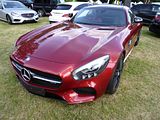
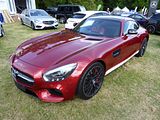
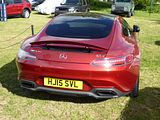
Some have complained that the latest AMG C63 is almost too subtle in appearance, which is a refreshing change from the rather brash styling that seems to afflict most of the rest of Mercedes’ latest models. There is nothing subtle about the noise that the 4 litre twin turbo engine makes though, when it is revved, as it was quite frequently during the day, for demo purposes. I drove the predecessor C63 model, and thought is very good indeed, so will be interested to try one of these to see what I think. The UK press seemed to rather like it.
A car I cannot warm to at all is the CLA. Gawky looking, and with truly appalling rear seat access, and no space for occupants if they ever do manage to get in it, it is apparently not even very good to drive in the entry level models, which are still extremely expensive for what they are. The recently released Shooting Break version does little to change any of that, with its rear end aping the later CLS Shooting Break, but leaving the brash front end, and with rear doors still making it hard to get in and out. in CLA 45AMG guise, the car is blisteringly fast, of course, but with a starting price of well north of £40k, even without any options on it, it is also far too expensive to be anything other than a very pricey indulgence for someone who simply wants bragging rights on the bhp of his Merc.
I am not particularly keen on the styling of the latest large Mercedes models, either, which have eschewed the traditional elegance that used to characterise them, with an excess of lines, curves, swages, surfaces, and far too many fussy details. There can be no denying their mechanical and electronic sophistication, and that they are allegedly good to drive, but visually the SL63AMG and the current S Class don’t do it for me at all.
I’m not particularly keen on the SLK55 AMG, either. The once lithe and small sports car has put on girth and flab as Mercedes has made each successive generation larger than the last.
MINI
Claiming pride of place in the MINI display was the latest John Cooper Works version of the third generation Hatchback model, which has just gone on sale. The most powerful regular production MINI yet, this car will appeal to all those who liked -and had deep enough pockets for – the previous version. Be in no doubt, though that this can get very costly if you are anything other than careful with the options list.
Also shown were examples of the rest of the range including the Cabrio, Coupe, Countryman and Paceman, and there was one of the limited edition GP cars here as well.
MITSUBISHI
There were some Mitsubishi models on show, but it as measure of what their range has been reduced to, that I did not take pictures of any of them.
SUZUKI
A line of new Suzuki models showed the range has been refreshed by the replacement of the Alto and Splash models with the well received (once the brake issue was addressed, which, to Suzuki’s credit it was, and quickly) Celerio and the small Crossover Vitara, as well as the familiar Swift and SX4 S-Cross.
VAUXHALL
The Vauxhall display also included a mix of current and older, classic models. Showing the evolution of the family sized hot hatch were a second generation Astra GTE and the latest Astra VXR.
Vauxhall replaced the Corsa with a new model last year. I still find it hard to believe claims that it truly is “all new”, as there are plenty of reports to suggest that it is in fact a fairly comprehensive reworking of the previous model. Apparently it drives better, and the interior has taken a step forwards, but the looks are awkward to me in the detailing, and as for the VXR, well, let’s just say that it is even more clearly not for me than any of its predecessors.
The Adam is not for me, either. Although they are putting a brave face on it, and claiming sales success, I suspect that there are plenty of other people who don’t like it either. Last year I was told that the average age of the customers was a lot higher than had been expected with many older people trading down to one when they wanted a smaller car, whereas the target market had been all about youth. The latest engines have apparently made it less stodgy to drive, but it would still not be my choice of a premium small car, even in one of the less bizarre colour schemes.
Far more to my taste is the VXR8 GTS. the last remaining Aussie muscle car, as this is really a Holden Commodore HSV in disguise, this car is not only brutally fast but has a wonderful soundtrack emanating from under the bonnet. Sadly, a prodigious thirst and a very high CO2 rating will keep it a rare sight on our roads, but if you can afford it, a second hand one (which will doubtless suffer catastrophic levels of deprecation) would be a lot of fun.
As well as the Lotus Carlton from the Vauxhall Heritage fleet, there was an example of the VX220 on display. This was a brave, and unprecedented move by The General, in Europe, to enter the 2 seater sports car market. Although it looks quite different, the VX220 and its Opel Speedster alter ego share much under the skin with the Lotus Elise, and indeed the cars were built for General Motors, by Lotus at Hethel, the result of a deal between GM and Lotus, struck to generate enough funding for the latter to be able to develop a replacement for their Elise model, something forced on them owing to changes in European crash safety regulations for the 2000 model year and to give Vauxhall and Opel an entry in what was clearly a small but sizeable enough market for cars of this genre as proven by the Japanese. Lotus agreed to develop and produce a 2 seater sports car for GM, on the new Series 2 Elise chassis, with the a concept version of the proposed GM model being shown at the Geneva Motor Show in 1999. Although the body styling was different, clearly the economies would only work if as much else could be shared, and that presented a challenge as it was planned to use a 1.8-litre Toyota engine, similar to that found in the Toyota Celica, in the second generation Elise, whereas the GM cars clearly had to use a GM engine, namely the 2.2-litre GM Ecotec engine from the Astra. As neither engine had been used in the original Elise, which had been fitted with a 1.8-litre Rover K-Series engine, this simply became one of the many design challenges .In order to accommodate the production of the new cars, Lotus expanded its Hethel factory to a capacity of 10,000 cars, with around 3,500 slots allocated to Speedster production. Production of the Speedster commenced in 2000. The car was hailed by the motoring press as a great drivers’ car and won several accolades, including Top Gear’s Car of the Year in 2003. The lesser naturally aspirated 2.2 version was considered easier to drive than the potent Turbo model, and some journalists suggested that the Opel/Vauxhall car was better value for money than the Lotus, among them one Jeremy Clarkson in his 2003 DVD Shoot Out. However, the market did not really agree, and sales were limited. The car was deleted in 2005, with no successor.
VOLKSWAGEN
Highlight for me on this stand was that it had an XL1 on it. Still looking like nothing else on 4 wheels, this futuristic design is one of my favourites of recent times. Designed to be able to travel 100 km on 1 litre of diesel fuel, which equates to 280 mpg, while being both roadworthy and practical, the car had to be not just supremely aerodynamic, but produced with lightweight materials and fitted with an engine and transmission designed and tuned for economy. It took a while to hit the goal, with a concept car being seen first in 2009 as the L1, and then later in 2011 as the XL1. Fitted with a diesel-electric hybrid motor, its 5.5 kWh lithium-ion battery delivers an all-electric range of 50 km (31 miles), has a fuel economy of 0.9 l/100 km (310 mpg) under the NEDC cycle and produces emissions of 21 g/km of CO2. A limited production of 250 units began in mid 2013, with pricing starting at €111,000. Around 20 are believed to have come to the UK.The XL1 was released to retail customers in Germany in June 2014.
More familiar VW models ranged from the recently facelifted Polo and Scirocco through the 2015 Car of the Year winning all-new Passat, to the much lauded Golf R and the long running Tiguan.
VOLVO
This was my first chance to see an example of the new XC90 on British soil, the car having been launched in the UK the preceding day. Even better, I found a quiet time on the dealer’s stand so did not have fight to get a good look, as has been the case at all the shows where I have seen it since its unveiling in mid 2014. I am still of the opinion that this is a very impressive looking car, with a beautifully finished interior that is nice and simply, in true Swedish style. Yet, look closely and everything is there, proving that you do not need the surfeit of buttons that some manufacturers seem to think are de rigeur these days. Demand has been high, and no wonder. For those who want a car in this class, although it is not particularly cheap, it is the one I would unhesitatingly recommend and indeed pick for myself.
The display also included examples of more familiar offerings from the Volvo range, including a V70 and the highly rated XC60.
THORNLEY KELHAM
Dealer and restorer Thornley Kelham had a large 80 foot marquee at one end of the west lawn, and their display contained seven cars in various states of repair and readiness for sale, with some shown outside the marquee. All these, and two of those in the marquee would not have looked out of place in the Concours which started just beyond their marquee. Cars not quite ready for concours yet included a 1934 Rolls Royce Phantom 2 part way through a complete nut and bolt restoration which drew large crowds and elicited many questions about the process. Also on display was a Mercedes 300SL Coupe ‘Gullwing’ chassis in its painted state, and its engine on a stand; a Lancia Aurelia B24 Spider body illustrating the various stages of paint preparation; a barn-find Lancia Flaminia Zagato Sport next to a fully restored one, which demonstrated just what can be achieved with a lot of hard work, patience and attention to detail. A supercharged Amilcar engine enthralled true enthusiasts whilst a range of newly-painted parts on display provided both staff and visitors alike with various topics of conversation. Parked up along with these were a wonderful 1950 Ferrari 195S Inter which the firm prepares and maintains for rallying around Europe on behalf of the owner; and a 1960 Mercedes Benz 220SE Cabriolet; a stylish member of the “Ponton” style of Mercedes made between 1954 and 1961. This one was offered for sale, at an eye-watering £160,000. It’s nice, but maybe not quite that nice!
Outside the marquee were a 1953 Bentley Continental R-Type which drew lots of admirers; a Porsche 911 2.7 RS; a 1956 VW Camper Van which was the most photographed car of the lot and a 1991 Bugatti EB110 America which wowed the crowd.
WHAT ELSE IS THERE TO SAY?
I can’t complete the report without mentioning the Saturday evening. In 2014, we found that hotels in the Wilton/Salisbury area are quite limited in supply, and ended up staying in Eastleigh, which is quite a trek to Wilton. So for 2015, as soon as the dates were announced, a bit of Googling turned up a nice cottage, which it said was pretty near Salisbury, and would sleep the 3 of us. A second cottage was adjoining, and it would be possible to book the whole complex should one need to. We did not, so booked just the larger of the 2 cottages for what seemed like a bargain price, and thought not a lot more of it. On arriving – and I was the first to get there – I was somewhat surprised to find that the car already parked outside was nothing less than a Ferrari F12 Berlinetta. It was fairly obvious that this was the car of the occupants of the other cottage rather the property’s owners. Needless to say, my camera was out as soon as I had parked my red Italian car up.
The cottage owners had told us that if they were not around -and they were not, when we arrived – that the place would be open and there would be a key inside. And so it turned out to be, and I wandered, jaw on the floor, in delight at what we had booked. It was way better even than the pictures, and I have to say was absolutely beautifully finished, equipped and presented. Accordingly, I am not going to let on as to where it was, as you will not be surprised to learn that we rather fancy staying there in 2016! It turned out that the cottage is new, and the pricing was rather a shot in the dark, so it will cost more next year, but even so, it will be worth it. With or without an F12 parked outside! Not only was the cottage lovely, but there was pub right across the road which did excellent food and gave cottage residents a free bottle of wine. It was whilst we were satisfying our hunger and thirst that we could hear the unmistakable sound of a Ferrari being revved hard. Of course, the owner of the F12 had been prevailed on to go across the road and fire it up!
Needless to say, we felt the need for a few more pictures of our cars in such a setting. The following morning, I did take a couple more but heavy condensation was still on the cars, so these were not as good as those from the night before, when long shadows had been a challenge.
This was an utterly brilliant weekend. Indeed, when we reach December, and I come to review the many events of 2015, this one will be right at the top of the list as a contender for Best Weekend of the Year. As soon as the 2016 dates are announced, it goes in my diary (and that cottage gets booked!).


